There’s a great story by Ed Yong over at The Atlantic about the fact that, as he explained on Twitter, “hundreds of undiscovered species lurk in the drawers of museums.” Natural history collections, Yong writes, are actually “time capsules that contain records of past ecosystems that are rapidly changing or disappearing. They are archives that provide clues about raging epidemics, environmental pollution, and hidden extinctions. And they are full of unknown species—like the sacred crocodile.” Check it out. If you like natural history museums as much as I do, meanwhile, you might also enjoy Richard Fortey’s book, Dry Storeroom No. 1: The Secret Life of the Natural History Museum.
Tag: Biology
Rootstocks and Rhizotrons
Edible Geography explores the exhumation of whole trees in a new post called “Rootstock Archaeology.” Don’t miss the incredible rhizotron, “an underground corridor whose walls consist of forty-eight shuttered windows, which researchers can open to peer out onto the root systems of adjacent trees and plants.”
In the Garden of 3D Printers
 [Image: Unrelated image of incredible floral shapes 3D-printed by Jessica Rosenkrantz and Jesse Louis-Rosenberg (via)].
[Image: Unrelated image of incredible floral shapes 3D-printed by Jessica Rosenkrantz and Jesse Louis-Rosenberg (via)].
A story published earlier this year explained how pollinating insects could be studied by way of 3D-printed flowers.
The actual target of the study was the hawkmoth, and four types of flowers were designed and produced to help understand the geometry of moth/flower interactions, including how “the hawkmoth responded to each of the flower shapes” and “how the flower shape affected the ability of the moth to use its proboscis (the long tube it uses as a mouth).”
Of course, a very similar experiment could have been done using handmade model flowers—not 3D printers—and thus could also have been performed with little fanfare generations ago.
But the idea that a surrogate landscape can now be so accurately designed and manufactured by printheads that it can be put into service specifically for the purpose of cross-species dissimulation—that it, tricking species other than humans into thinking that these flowers are part of a natural ecosystem—is extraordinary.
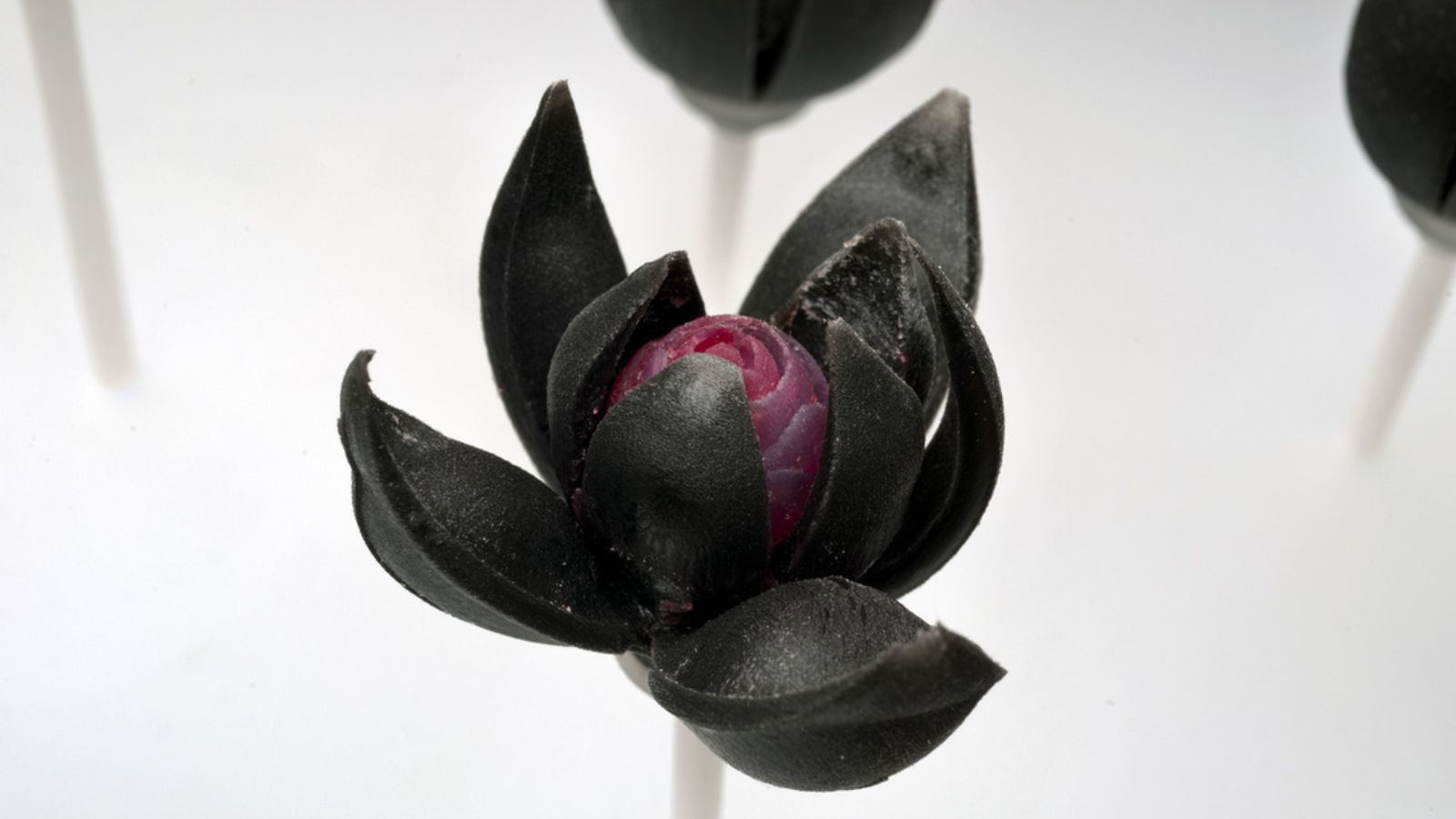 [Image: An also unrelated project called “Blossom,” by Richard Clarkson].
[Image: An also unrelated project called “Blossom,” by Richard Clarkson].
Many, many years ago, I was sitting in a park in Providence, Rhode Island, one afternoon reading a copy of Germinal Life by Keith Ansell Pearson. The book had a large printed flower on its front cover, wrapping over onto the book’s spine.
Incredibly, at one point in the afternoon a small bee seemed to become confused by the image, as the bee kept returning over and over again to land on the spine and crawl around there—which, of course, might have had absolutely nothing to do with the image of a printed flower, but, considering the subject matter of Ansell Pearson’s book, this was not without significant irony.
It was as if the book itself had become a participant in, or even the mediator of, a temporary human/bee ecosystem, an indirect assemblage created by this image, this surrogate flower.
In any case, the image of little gardens or entire, wild landscapes of 3D-printed flowers so detailed they appear to be organic brought me to look a little further into the work of Jessica Rosenkrantz and Jesse Louis-Rosenberg, a few pieces of whose you can see in the opening image at the top of this post.
Their 3D-printed floral and coral forms are astonishing.
 [Image: “hyphae 3D 1” by Jessica Rosenkrantz and Jesse Louis-Rosenberg].
[Image: “hyphae 3D 1” by Jessica Rosenkrantz and Jesse Louis-Rosenberg].
Rosenkrantz’s Flickr page gives as clear an indication as anything of what their formal interests and influences are: photos of coral, lichen, moss, mushrooms, and wildflowers pop up around shots of 3D-printed models.
They sometimes blend in so well, they appear to be living specimens.
 [Image: Spot the model; from Jessica Rosenkrantz’s Flickr page].
[Image: Spot the model; from Jessica Rosenkrantz’s Flickr page].
There is an attention to accuracy and detail in each piece that is obvious at first glance, but that is also made even more clear when you see the sorts of growth-studies they perform to understand how these sorts of systems branch and expand through space.
 [Image: “Floraform—Splitting Point Growth” by Jessica Rosenkrantz and Jesse Louis-Rosenberg].
[Image: “Floraform—Splitting Point Growth” by Jessica Rosenkrantz and Jesse Louis-Rosenberg].
The organism as space-filling device.
And the detail itself is jaw-dropping. The following shot shows how crazy-ornate these things can get.
 [Image: “Hyphae spiral” by Jessica Rosenkrantz and Jesse Louis-Rosenberg].
[Image: “Hyphae spiral” by Jessica Rosenkrantz and Jesse Louis-Rosenberg].
Anyway, while this work is not, of course, related to the hawkmoth study with which this post began, it’s nonetheless pretty easy to get excited about the scientific and aesthetic possibilities opened up by some entirely speculative future collaboration between these sorts of 3D-printed models and laboratory-based ecological research.
One day, you receive a mysterious invitation to visit a small glass atrium constructed atop an old warehouse somewhere on the outskirts of New York City. You arrive, baffled as to what it is you’re meant to see, when you notice, even from a great distance, that the room is alive with small colorful shapes, flickering around what appears to be a field of delicate flowers. As you approach the atrium, someone opens a door for you and you step inside, silent, slightly stunned, noticing that there is life everywhere: there are lichens, orchids, creeping vines, and wildflowers, even cacti and what appears to be a coral reef somehow inexplicably growing on dry land.
But the room does not smell like a garden; the air instead is charged with a light perfume of adhesives.
 [Image: “Hyphae crispata #1 (detail)” by Jessica Rosenkrantz and Jesse Louis-Rosenberg].
[Image: “Hyphae crispata #1 (detail)” by Jessica Rosenkrantz and Jesse Louis-Rosenberg].
Everything you see has been 3D-printed, which comes as a shock as you begin to see tiny insects flittering from flowerhead to flowerhead, buzzing through laceworks of creeping vines and moss—until you look even more carefully and realize that they, too, have been 3D-printed, that everything in this beautiful, technicolor room is artificial, and that the person standing quietly at the other end amidst a tangle of replicant vegetation is not a gardener at all but a geometrician, watching for your reaction to this most recent work.
Abandoned Mines, Slow Printing, and the Living Metal Residue of a Post-Human World
“High in the Pyrenees Mountains,” we read, “deep in abandoned mines, scientists discovered peculiar black shells that seem to crop up of their own accord on metal surfaces.”
 [Image: Metal shells growing in the darkness of abandoned mines; photo by Joan Santamaría, via Eos].
[Image: Metal shells growing in the darkness of abandoned mines; photo by Joan Santamaría, via Eos].
No, this is not a deleted scene from Jeff VanderMeer’s Southern Reach trilogy; it’s from research published in the Journal of Geophysical Research: Biogeosciences, recently reported by Eos.
It turns out that, under certain conditions, subterranean microbes can leave behind metallic deposits “as part of their natural metabolism.” Abandoned mines are apparently something of an ideal environment for this to occur within, resulting in “a rapid biomineralization process that sprouts iron-rich shells from the surface of steel structures.”
These then build up into reef-like deposits through a process analogous to 3D-printing: “Electron microscopy revealed small-scale, fiber-like crystals arranged into lines growing outward from the steel surface. The shells appear to be formed layer by layer, with crystal size and composition varying across layers.”
There are many, many interesting things to highlight here, which include but are not limited to:
Slow Printing
We could literalize the analogy used above by exploring how a controlled or guided version of this exact same process could be used as a new form of biological 3D-printing.
To put this another way, there is already a slow food movement—why not a slow printing one, as well?
Similar to the project John Becker and I explored a while back, using genetically-modified bees as living printheads, damp, metal-rich environments—microbial ovens, so to speak—could be constructed as facsimile mines inside of which particular strains of microbes and fungi would then be cultivated.
Geometric molds would be introduced as “seed-forms” to be depositionally copied by the microbes. Rather than creating the abstract, clamshell-like lumps seen in the below photograph, the microbes would be steered into particular shapes and patterns, resulting in discrete, recognizable objects.
Boom: a living 3D-printer, or a room of specially cultivated humidity and darkness out of which strange replicant tools and objects could be extracted every few years. At the very least, it would make a compelling art project—an object-reef sprouting with microbial facsimiles.
 [Image: Metal shells growing in the darkness of abandoned mines; photo by Nieves López-Martínez, via Eos].
[Image: Metal shells growing in the darkness of abandoned mines; photo by Nieves López-Martínez, via Eos].
Dankness Instrumentalized
Historian David Gissen has written interestingly about the idea of “dankness” in architecture.
In an article for Domus back in 2010, Gissen explained that “dankness”—or “underground humidity,” in his words, a thick atmosphere of mold, rot, and stagnation usually found inside closed, subterranean spaces—was even once posited by architectural historian Marc-Antoine Laugier as a primal catalyst for first inspiring human beings to build cleaner, better ventilated structures—that is, architecture itself, in a kind of long-term retreat from the troglodyte lifestyle of settling in caves.
Dankness, to wildly over-simply this argument, so horrified our cave-dwelling ancestors that they invented what we now call architecture—and a long chain of hygienic improvements in managing the indoor atmospheric quality of these artificial environments eventually led us to modernism.
But dankness has its uses. “While modernists generally held dankness in suspect,” Gissen writes, “a few held a certain type of affection for this atmosphere, if only because it was an object of intense scrutiny. The earliest modernist rapprochements with dankness saw it as the cradle of a mythical atmosphere, an atmosphere that preceded modernity.” The “atmospheric depths of the cellar,” Gissen then suggests, might ironically be a sign of architectural developments yet to come:
Today, in the name of environmentalism, architects are digging into the earth in an effort to release its particular climatic qualities. Passive ventilation schemes often involve underground constructions such as “labyrinths” or “thermosiphons” that release the earth’s cool and wet air. The earth that architects reach into is one that has been so technified and rationalized, so measured and considered, that it barely contains mythical or uncanny aspects. However, this return to the earth’s substrate enables other possibilities.
In any case, I am not only quoting this essay because it is interesting and deserves wider discussion; I am also quoting all this in order to suggest that dankness could also be instrumentalized, or tapped as a kind of readymade industrial process, an already available microbial atmosphere wherein metal-depositing metabolic processes pulsing away in the dankest understructures of the world could be transformed into 3D-printing facilities.
The slow printheads for long-term object replication, mentioned above, would be fueled by and dependent upon Gissen’s spaces of subterranean humidity.
Heavy Metal Compost
If it is too difficult, too unrealistic, or simply too uselessly speculative to consider the possibility of 3D-printing with microbes, you could simply eliminate the notion that this is meant to produce recognizable object-forms, and use the same process instead as a new kind of compost heap.
Similar to throwing your old banana peels, coffee grounds, apple cores, and avocado skins into a backyard compost pile, you could throw metallic waste into a Gissen Hole™ and wait for genetically-modified microbes such as these to slowly but relentlessly break it all down, leaving behind weird, clamshell-like structures of purified metal in their wake.
Cropping teams would then climb down into this subterranean recycling center—or open an airlock and step inside some sort of controlled-atmosphere facility tucked away on the industrial outskirts of town—to harvest these easily commodified lumps of metal. It’d be like foraging for mushrooms or picking strawberries.
 [Image: An “ancient coral reef,” illustrated by Heinrich Harder].
[Image: An “ancient coral reef,” illustrated by Heinrich Harder].
The Coming Super-Reef
Finally, this also seems to suggest at least one fate awaiting the world of human construction long after humans themselves have disappeared.
Basements in the ruined cores of today’s cities will bloom in the darkness with ever-expanding metallic reefs, as the steel frames of skyscrapers and the collapsed machinery of the modern world become source material—industrial soil—for future metal-eating microbes.
Quietly, endlessly, wonderfully, the planet-spanning dankness of unmaintained subterranean infrastructure—in the depths of Shanghai, London, New York, Moscow—humidly accumulates these strange metallic shells. Reefs larger than anything alive today form, crystallized from the remains of our cities.
A hundred million years go by, and our towers are reduced to bizarre agglomerations of metal—then another hundred million years and they’ve stopped growing, now hidden beneath hundreds of meters of soil or flooded by unpredictable shifts of sea level.
Clouds of super-fish unrecognizable to today’s science swim through the grotesque arches and coils of what used to be banks and highways, apartment blocks and automobiles, monstrous and oyster-like shells whose indirect human origins no future paleontologist could realistically deduce.
Life on the Subsurface: An Interview with Penelope Boston
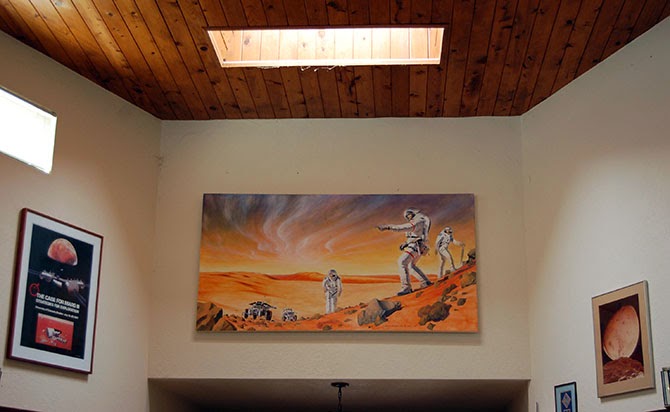 A landscape painting above Penny Boston’s living room entryway depicts astronauts exploring Mars.
A landscape painting above Penny Boston’s living room entryway depicts astronauts exploring Mars.
Penelope Boston is a speleo-biologist at New Mexico Tech, where she is also Director of Cave and Karst Science. Her work examines subterranean lifeforms, often found very deep within cave systems, including the larger subterranean ecosystems those creatures are connected to. Her research focuses primarily on what are known as extremophiles for their ability to survive in seemingly inhospitable micro-environments here on Earth; these bizarre forms of life, thriving in acidic, anoxic, or highly pressurized situations, offer compelling analogies for the sorts of lifeforms and ecosystems that might exist, undetected, on other planets.
But the flip side of her research are those environments themselves: the caves, tunnels, and other underground spaces inside of which unearthly life might thrive. As you’ll see, this is an interview obsessed with space: how to define space, how space is formed geologically, and what sorts of speculative underground spaces and structures can form under radically different gravitational regimes, deep inside the polar glaciers of distant moons, or even in the turbulent skies of gas giants.
Boston has worked with the NASA Innovative Advanced Concepts program (NIAC) to develop protocols for both human extraterrestrial cave habitation and for subterranean life-detection missions on Mars, life which she believes is highly likely to exist.
On a hot summer afternoon, she graciously welcomed me and Nicola Twilley, traveling for our Venue project, into her home in Los Lunas, New Mexico, where we arrived with design futurist Stuart Candy in tow, en route to dropping him off at the Very Large Array later that day.
Over the course of our conversation, Boston told us about her experiences working at Mars analog sites; she explained why she believes there is a strong possibility for life below the surface of the Red Planet, perhaps inside billion-year-old networks of lava tubes; she detailed her own ongoing cave explorations beneath the U.S. Southwest; and we touched on some mind-blowing ideas seemingly straight out of science fiction, including extreme forms of extraterrestrial life (such as dormant life on comets, thawed and reawakened with every passage close to the sun) and the extraordinary potential for developing new pharmaceuticals out of cave microorganisms.
An edited transcript of our conversation appears below.
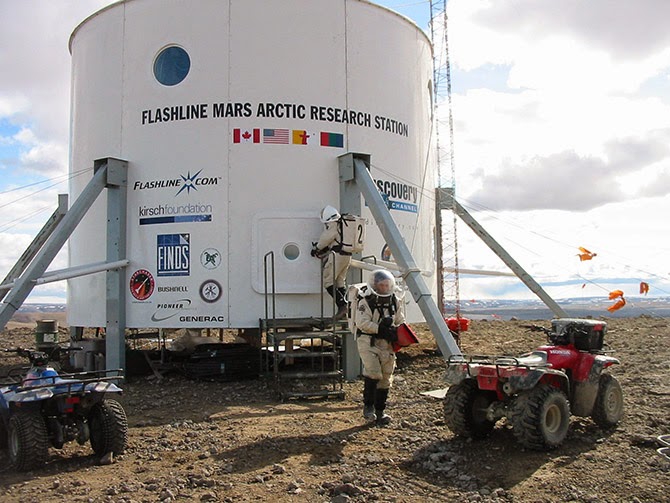 The Flashline Mars Arctic Research Station (FMARS) on Devon Island, courtesy of the Mars Society.
The Flashline Mars Arctic Research Station (FMARS) on Devon Island, courtesy of the Mars Society.Geoff Manaugh: As a graduate student, you co-founded the Mars Underground and then the Mars Society. You’re a past President of the Association of Mars Explorers, and you’re also now a member of the science team taking part in Mars Arctic 365, a new one-year Mars surface simulation mission set to start in summer 2014 on Devon Island. How does this long-term interest in Mars exploration tie into your Earth-based research in speleobiology and subterranean microbial ecosystems?
Penelope Boston: Even though I do study surface things that have a microbial component, like desert varnish and travertines and so forth, I really think that it’s the subsurface of Mars where the greatest chance of extant life, or even preservation of extinct life, would be found.
Nicola Twilley: Is it part of NASA’s strategy to go subsurface at any point, to explore caves on Mars or the moon?
Boston: Well, yes and no. The “Strategy” and the strategy are two different things.
The Mars Curiosity rover is a very capable chemistry and physics machine and I am, of course, dying to hear the details of the geochemistry it samples. A friend of mine, for instance, with whom I’m also a collaborator, is the principal investigator of the SAM instrument. Friends of mine are also on the CheMin instrument. So I have a vested interest, both professionally and personally, in the Curiosity mission.
On the other hand, you know: here we go again with yet another mission on the surface. It’s fascinating, and we still have a lot to learn there, but I hope I will live long enough to see us do subsurface missions on Mars and even on other bodies in the solar system.
Unfortunately, right now, we are sort of in limbo. The downturn in the global economy and our national economy has essentially kicked NASA in the head. It’s very unclear where we are going, at this point. This is having profound, negative effects on the Agency itself and everyone associated with it, including those of us who are external fundees and sort of circum-NASA.
On the other hand, although we don’t have a clear plan, we do have clear interests, and we have been pursuing preliminary studies. NASA has sponsored a number of studies on deep drilling, for example. One of the most famous was probably about 15 years ago, and it really kicked things off. That was up in Santa Fe, and we were looking at different methodologies for getting into the subsurface.
I have done a lot of work, some of which has been NASA-funded, on the whole issue of lava tubes—that is, caves associated with volcanism on the surface. Now, Glenn Cushing and Tim Titus at the USGS facility in Flagstaff have done quite a bit of serious work on the high-res images coming back from Mars, and they have identified lava tubes much more clearly than we ever did in our earlier work over the past decade.
 Surface features created by lava tubes on Mars; image via ESA
Surface features created by lava tubes on Mars; image via ESA
Twilley: Is it the expectation that caves as common on Mars as they are on Earth?
Boston: I’d say that lava tubes are large, prominent, and liberally distributed everywhere on Mars. I would guess that there are probably more lava tubes on Mars than there are here on Earth—because here they get destroyed. We have such a geologically and hydro-dynamically active planet that the weathering rates here are enormous.
But on Mars we have a lot of factors that push in the other direction. I’d expect to find tubes of exceeding antiquity—I suspect that billions-of-year-old tubes are quite liberally sprinkled over the planet. That’s because the tectonic regime on Mars is quiescent. There is probably low-level tectonism—there are, undoubtedly, Marsquakes and things like that—but it’s not a rock’n’roll plate tectonics like ours, with continents galloping all over the place, and giant oceans opening up across the planet.
That means the forces that break down lava tubes are probably at least an order of magnitude or more—maybe two, maybe three—less likely to destroy lava tubes over geological time. You will have a lot of caves on Mars, and a lot of those caves will be very old.
Plus, remember that you also have .38 G. The intrinsic tensile strength of the lava itself, or whatever the bedrock is, is also going to allow those tubes to be much more resistant to the weaker gravity there.

 Surface features of lava tubes on Mars; images via ESA
Surface features of lava tubes on Mars; images via ESA
Manaugh: I’d imagine that, because the gravity is so much lower, the rocks might also behave differently, forming different types of arches, domes, and other formations underground. For instance, large spans and open spaces would be shaped according to different gravitational strains. Would that be a fair expectation?
Boston: Well, it’s harder to speculate on that because we don’t know what the exact composition of the lava is—which is why, someday, we would love to get a Mars sample-return mission, which is no longer on the books right now. [sighs] It’s been pushed off.
In fact, I just finished, for the seventh time in my career, working on a panel on that whole issue. This was the E2E—or End-to-End—group convened by Dave Beatty, who is head of the Mars Program at the Jet Propulsion Laboratory [PDF].
About a year ago, we finished doing some intensive international work with our European Space Agency partners on Mars sample-return—but now it’s all been pushed off again. The first one of those that I worked on was when I was an undergraduate, almost ready to graduate at Boulder, and that was 1979. It just keeps getting pushed off.
I’d say that we are very frustrated within the planetary and astrobiology communities. We can use all these wonderful instruments that we load onto vehicles like Curiosity and we can send them there. We can do all this fabulous orbital stuff. But, frankly speaking, as a person with at least one foot in Earth science, until you’ve got the stuff in your hands—actual physical samples returned from Mars—there is a lot you can’t do.
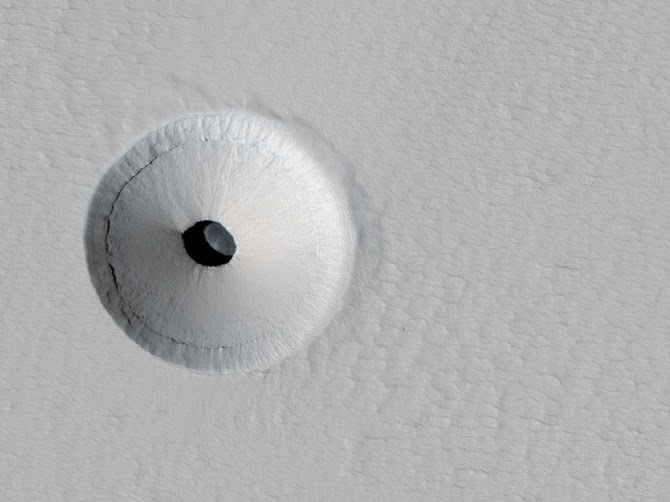
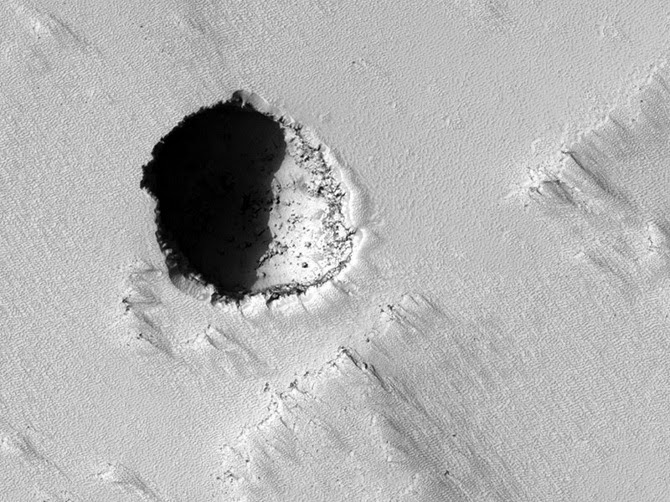 Looking down through a “skylight” on Mars and into a Martian sinkhole; images via NASA/JPL/University of Arizona
Looking down through a “skylight” on Mars and into a Martian sinkhole; images via NASA/JPL/University of Arizona
Twilley: Could you talk a bit about your work with exoplanetary research, including what you’re looking for and how you might find it?
Boston: [laughs] The two big questions!
But, yes. We are working on a project at Socorro now to atmospherically characterize exoplanets. It’s called NESSI, the New Mexico Exoplanet Spectroscopic Survey Instrument. Our partner is Mark Swain, over at JPL. They are doing it using things like Kepler, and they have a new mission they’re proposing, called FINESSE. FINESSE will be a dedicated exoplanet atmospheric characterizer.
We are also trying to do that, in conjunction with them, but from a ground-based instrument, in order to make it more publicly accessible to students and even to amateur astronomers.
That reminds me—one of the other people you might be interested in talking to is a young woman named Lisa Messeri, who just recently finished her PhD in Anthropology at MIT. She’s at the University of Pennsylvania now. Her focus is on how scientists like me to think about other planets as other worlds, rather than as mere scientific targets—how we bring an abstract scientific goal into the familiar mental space where we also have recognizable concepts of landscape.
I’ve been obsessed with that my entire life: the concept of space, and the human scaling of these vastly scaled phenomena, is central, I think, to my emotional core, not just the intellectual core.
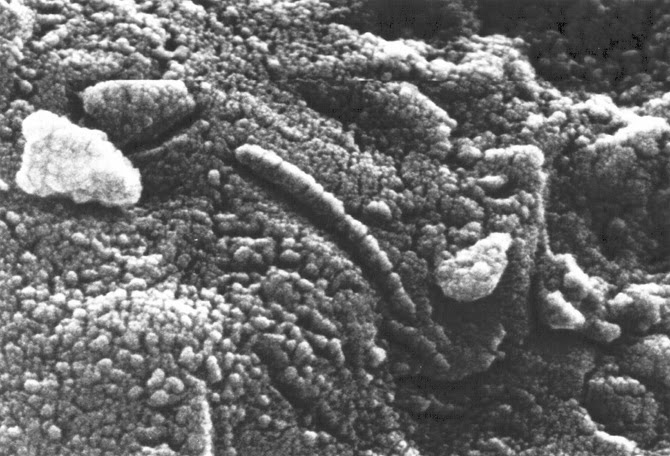 The Allan Hills Meteorite (ALH84001); courtesy of NASA.
The Allan Hills Meteorite (ALH84001); courtesy of NASA.
Manaugh: While we’re on the topic of scale, I’m curious about the idea of astrobiological life inhabiting a radically, undetectably nonhuman scale. For example, one of the things you’ve written and lectured about is the incredible slowness it takes for some organisms to form, metabolize, and articulate themselves in the underground environments you study. Could there be forms of astrobiological life that exist on an unbelievably different timescale, whether it’s a billion-year hibernation cycle that we might discover at just the wrong time and mistake, say, for a mineral? Or might we find something on a very different spatial scale—for example, a species that is more like a network, like an aspen tree or a fungus?
Boston: You know, Paul Davies is very interested in this idea—the concept of a shadow biosphere. Of course, I had also thought about this question for many years, long before I read about Davies or before he gave it a name.
The conundrum you face is: how would you know—how you would study or even conceptualize—these other biospheres? It’s outside of your normal spatial and temporal comfort zone, in which all of your training and experience has guided you to look, and inside of which all of your instruments are designed to function. If it’s outside all of that, how will you know it when you see it?
Imagine comets. With every perihelion passage, volatile gases escape. You are whipping around the solar system. Your body comes to life for that brief period of time only. Now apply that to icy bodies in very elliptical orbits in other solar systems, hosting life with very long periods of dormancy.
There are actually some wonderful early episodes of The Twilight Zone that tap into that theme, in a very poetic and literary way. [laughs] Of course, it’s also the central idea of some of the earliest science fiction; I suppose Gulliver’s Travels is probably the earliest exploration of that concept.
In the microbial realm—to stick with what we do know, and what we can study—we are already dealing with itsy-bitsy, teeny-weeny things that are devilishly difficult to understand. We have a lot of tools now that enable us to approach those, but, very regularly, we’ll see things in electron microscopy that we simply can’t identify and they are very clearly structured. And I don’t think that they are all artifacts of the preparation—things that get put there accidentally during prep.
A lot of the organisms that we actually grow, and with which we work, are clearly nanobacteria. I don’t know how familiar you are with that concept, but it has been extremely controversial. There are many artifacts out there that can mislead us, but we do regularly see organisms that are very small. So how small can they be—what’s the limit?
A few of the early attempts at figuring this out were just childish. That’s a mean thing to say, because a lot of my former mentors have written some of those papers, but they would say things like: “Well, we need to conduct X, Y, and Z metabolic pathways, so, of course, we need all this genetic machinery.” I mean, come on, you know that early cells weren’t like that! The early cells—who knows what they were or what they required?
To take the famous case of the ALH84001 meteorite: are all those little doobobs that you can see in the images actually critters? I don’t know. I think we’ll never know, at least until we go to Mars and bring back stuff.
I have relatively big microbes in my lab that regularly feature little knobs and bobs and little furry things, that I am actually convinced are probably either viruses or prions or something similar. I can’t get a virologist to tell me yes. They are used to looking at viruses that they can isolate in some fashion. I don’t know how to get these little knobby bobs off my guys for them to look at.
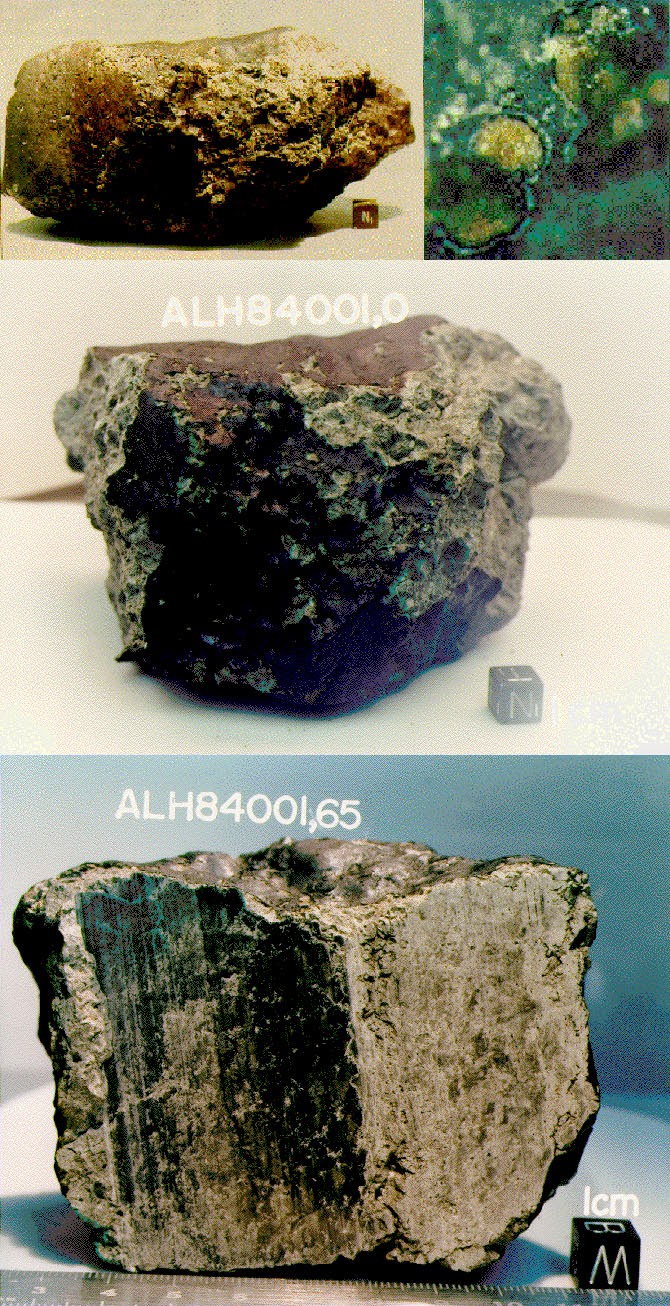 The Allan Hills Meteorite (ALH84001); courtesy of NASA.
The Allan Hills Meteorite (ALH84001); courtesy of NASA.
Twilley: In your paper on the human utilization of subsurface extraterrestrial environments [PDF], you discuss the idea of a “Field Guide to Unknown Organisms,” and how to plan to find life when you don’t necessarily know what it looks like. What might go into such a guide?
Boston: The analogy I often use with graduate students when I teach astrobiology is that, in some ways, it’s as if we are scientists on a planet orbiting Alpha Centauri and we are trying to write a field guide to the birds of Earth. Where do you start? Well, you start with whatever template you have. Then you have to deeply analyze every feature of that template and ask whether each feature is really necessary and which are just a happenstance of what can occur.
I think there are fundamental principles. You can’t beat thermodynamics. The need for input and outgoing energy is critical. You have to be delicately poised, so that the chemistry is active enough to produce something that would be a life-like process, but not so active that it outstrips any ability to have cohesion, to actually keep the life process together. Water is great as a solvent for that. It’s probably not the only solvent, but it’s a good one. So you can look for water—but do you really need to look for water?
I think you have to pick apart the fundamental assumptions. I suspect that predation is a relatively universal process. I suspect that parasitism is a universal process. I think that, with the mathematical work being done on complex, evolving systems, you see all these emerging properties.
Now, with all of that said, the details—the sizes, the scale, the pace, getting back to what we were just talking about—I think there is huge variability in there.
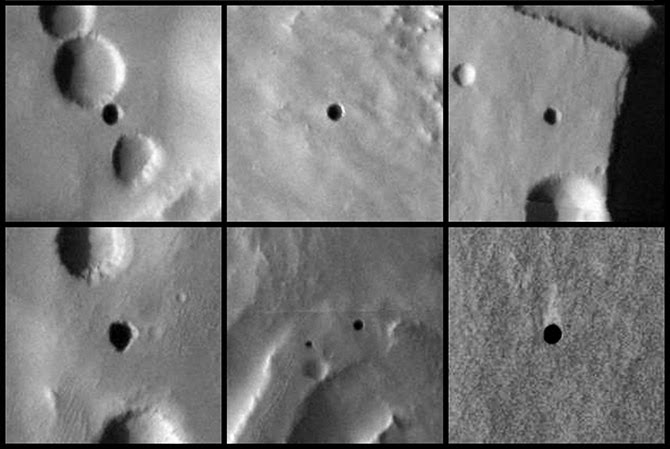 Caves on Mars; images courtesy of NASA/JPL-Caltech/ASU/USGS.
Caves on Mars; images courtesy of NASA/JPL-Caltech/ASU/USGS.
Twilley: How do you train people to look for unrecognizable life?
Boston: I think everybody—all biologists—should take astrobiology. It would smack you on the side of the head and say, “You have to rethink some of these fundamental assumptions! You can’t just coast on them.”
The organisms that we study in the subsurface are so different from the microbes that we have on the surface. They don’t have any predators—so, ecologically, they don’t have to outgrow any predators—and they live in an environment where energy is exceedingly scarce. In that context, why would you bother having a metabolic rate that is as high as some of your compatriots on the surface? You can afford to just hang out for a really long time.
We have recently isolated a lot of strains from these fluid inclusions in the Naica caves—the one with those gigantic crystals. It’s pretty clear that these guys have been trapped in these bubbles between 10,000 and 15,000 years. We’ve got fluid inclusions in even older materials—in materials that are a few million years old, even, in a case we just got some dates for, as much as 40 million years.
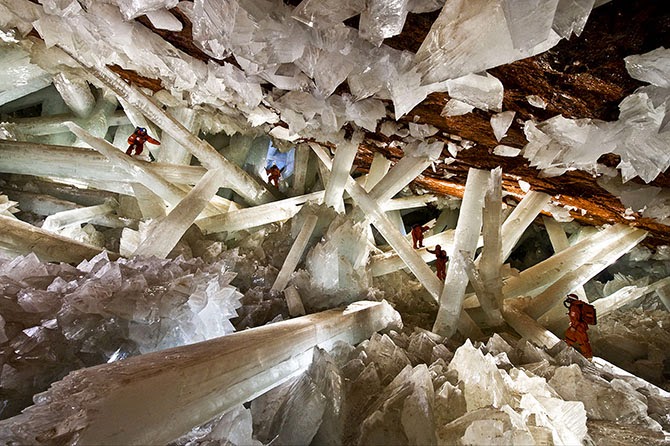 Naica Caves, image from the official website. The caves are so hot that explorers have to wear special ice-jackets to survive.
Naica Caves, image from the official website. The caves are so hot that explorers have to wear special ice-jackets to survive.
One of the caveats, of course, is that, when you go down some distance, the overlying lithostatic pressure of all of that rock makes space impossible. Microbes can’t live in zero space. Further, they have to have at least inter-grain spaces or microporosity—there has to be some kind of interconnectivity. If you have organisms completely trapped in tiny pockets, and they never interact, then that doesn’t constitute a biosphere. At some point, you also reach temperatures that are incompatible with life, because of the geothermal gradient. Where exactly that spot is, I don’t know, but I’m actually working on a lot of theoretical ideas to do with that.
In fact, I’m starting a book for MIT Press that will explore some of these ideas. They wanted me to write a book on the cool, weird, difficult, dangerous places I go to and the cool, weird, difficult bugs I find. That’s fine—I’m going to do that. But, really, what I want to do is put what we have been working on for the last thirty years into a theoretical context that doesn’t just apply to Earth but can apply broadly, not only to other planets in our solar system, but to one my other great passions, of course, which is exoplanets—planets outside the solar system.
One of the central questions that I want to explore further in my book, and that I have been writing and talking about a lot, is: what is the long-term geological persistence of organisms and geological materials? I think this is another long-term, evolutionary repository for living organisms—not just fossils—that we have not tapped into before. I think that life gets recycled over significant geological periods of time, even on Earth.
That’s a powerful concept if we then apply it to somewhere like Mars, for example, because Mars does these obliquity swings. It has super-seasonal cycles. It has these little dimpled moons that don’t stabilize it, whereas our moon stabilizes the Earth’s obliquity level. That means that Mars is going through these super cold and dry periods of time, followed by periods of time where it’s probably more clement.
Now, clearly, if organisms can persist for tens of thousands of years—let alone hundreds of thousands of years, and possibly even millions of years—then maybe they are reawakenable. Maybe you have this very different biosphere.
Manaugh: Like a biosphere in waiting.
Boston: Yes—a biosphere in waiting, at a much lower level.
Recently, I have started writing a conceptual paper that really tries to explore those ideas. The genome that we see active on the surface of any planet might be of two types. If you have a planet like Earth, which is photosynthetically driven, you’re going to have a planet that is much more biological in terms of the total amount of biomass and the rates at which this can be produced. But that might not be the only way to run a biosphere.
You might also have a much more low-key biosphere that could actually be driven by geochemical and thermal energy from the inside of the planet. This was the model that we—myself, Chris McKay, and Michael Ivanoff, one of our colleagues from what was the Soviet Union at the time—published more than twenty years ago for Mars. We suggested that there would be chemically reduced gases coming from the interior of the planet.
That 1992 paper was what got us started on caves. I had never been in a wild cave in my life before. We were looking for a way to get into that subsurface space. The Department of Energy was supporting a few investigators, but they weren’t about to share their resources. Drilling is expensive. But caves are just there; you can go inside them.
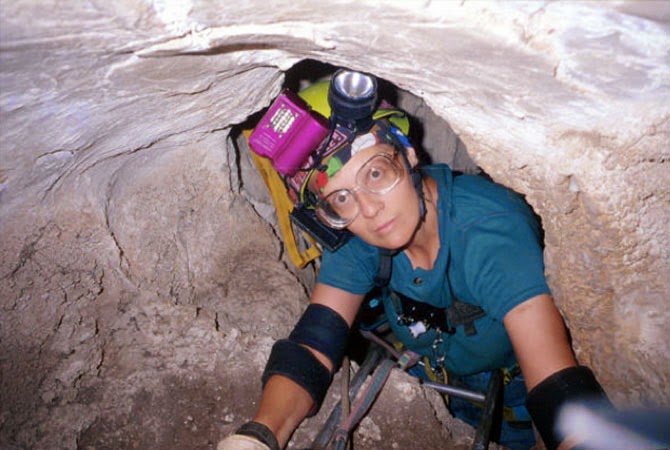 Penelope Boston caving, image courtesy of V. Hildreth-Werker, from “Extraterrestrial Caves: Science, Habitat, Resources,” NIAC Phase I Study Final Report, 2001.
Penelope Boston caving, image courtesy of V. Hildreth-Werker, from “Extraterrestrial Caves: Science, Habitat, Resources,” NIAC Phase I Study Final Report, 2001.
So that’s really what got us into caving. It was at that point where I discovered caves are so variable and fascinating, and I really refocused my career on that for the last 20 years.
The first time I did any serious caving was actually in Lechuguilla Cave. It was completely nuts to make that one’s first wild cave. We trained for about three hours, then we launched into a five-day expedition into Lechuguilla that nearly killed us! Chris McKay came out with a terrible infection. I had a blob of gypsum in my eye and an infection that swelled it shut. I twisted my ankle. I popped a rib. Larry Lemke had a massive migraine. We were not prepared for this. The people taking us in should have known better. But one of them is a USGS guide and a super caving jock, so it didn’t even occur to him—it didn’t occur to him that we were learning instantaneously to operate in a completely alien landscape with totally inadequate skills.
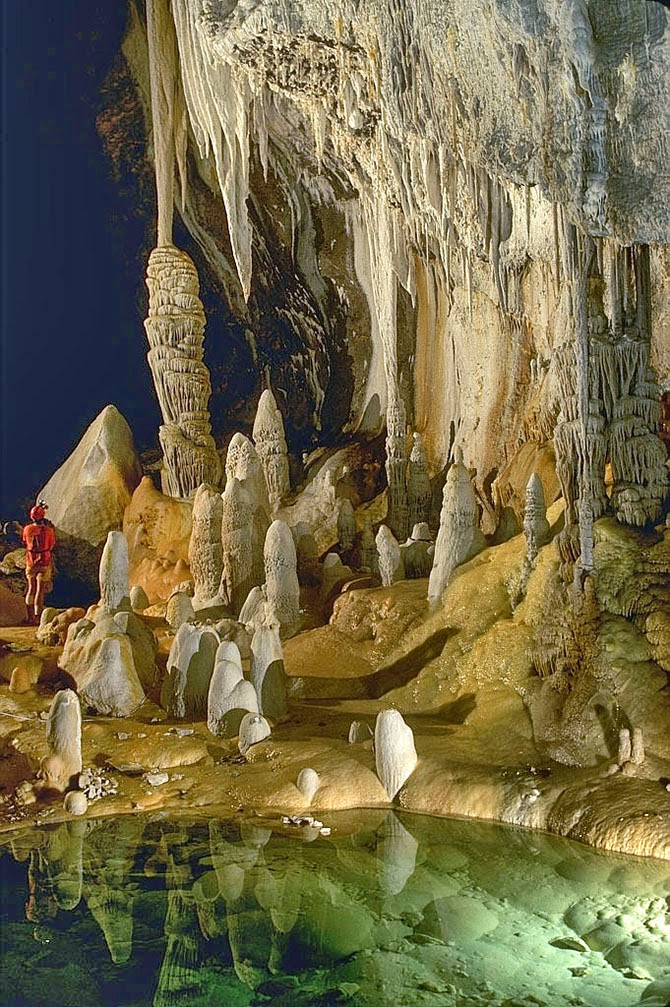 Lechuguilla Cave, photograph by Dave Bunnell.
Lechuguilla Cave, photograph by Dave Bunnell.
All I knew was that I was beaten to a pulp. I could almost not get across these chasms. I’m a short person. Everybody else was six feet tall. I felt like I was just hanging on long enough so I could get out and live. I’ve been in jams before, including in Antarctica, but that’s all I thought of the whole five days: I just have to live through this.
But, when I got out, I realized that what the other part of my brain had retained was everything I had seen. The bruises faded. My eye stopped being infected. In fact, I got the infection from looking up at the ceiling and having some of those gooey blobs drip down into my eye—but, I was like, “Oh my God. This is biological. I just know it is.” So it was a clue. And, when, I got out, I knew I had to learn how to do this. I wanted to get back in there.
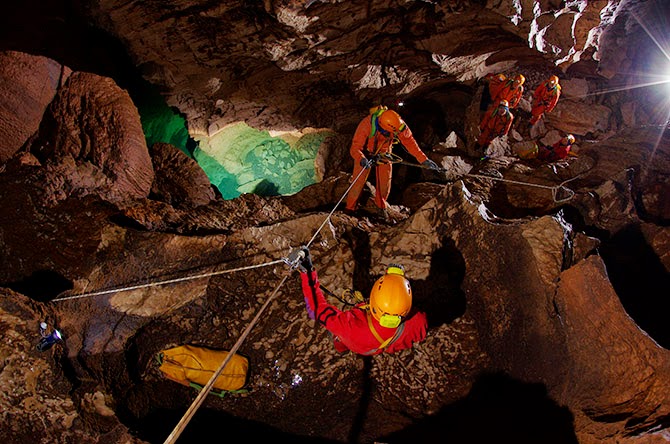 ESA astronauts on a “cave spacewalk” during a 2011 training mission in the caves of Sardinia; image courtesy of the ESA.
ESA astronauts on a “cave spacewalk” during a 2011 training mission in the caves of Sardinia; image courtesy of the ESA.
Manaugh: You have spoken about the possibility of entire new types of caves that are not possible on Earth but that might be present elsewhere. What are some of these other cave types you think might exist, and what sort of conditions would be required to form them? You’ve used some great phrases to describe those processes—things like “volatile labyrinths” and “ice volcanism” that create strange cave types that aren’t possible on Earth.
Boston: Well, in terms of ice, I’ll bet there are all sorts of Lake Vostok-like things out there on other moons and planets.
The thing with Lake Vostok is that it’s not a “lake.” It’s a cave: a cave in ice. The ice, in this case, acts as bedrock, so it’s not a lake at all. It’s a closed system.
Manaugh: It’s more like a blister: an enclosed space full of fluid.
Boston: Exactly. In terms of speculating on the kinds of caves that might exist elsewhere in the universe, we are actually working on a special issue for the Journal of Astrobiology right now, based on the extraterrestrial planetary caves meeting that we did last October. We brought people from all over the place. This is a collaboration between my Institute—the National Cave and Karst Research Institute in Carlsbad, where we have our headquarters—and the Lunar and Planetary Institute.
The meeting was an attempt to explore these ideas. Karl Mitchell from JPL, who I had not met previously, works on Titan; he’s on the Cassini Huygens mission. He thinks he is seeing karst-like features on Titan. Just imagine that! Hydrocarbon fluids producing karst-like features in water-ice bedrock—what could be more exotic than that?
That also shows that the planetary physics dominates in creating these environments. I used to think that the chemistry dominated. I don’t think so anymore. I think that the physics dominates. You have to step away from the chemistry at first and ask: what are the fundamental physics that govern the system? Then you can ask: what are the fundamental chemical potentials that govern the system that could produce life? It’s the same exercise with imagining what kind of caves you can get—and I have a lurid imagination.
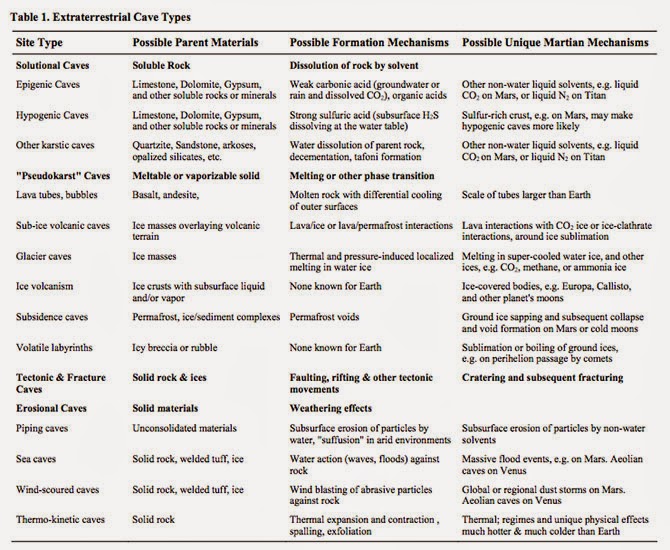 From “Human Utilization of Subsurface Extraterrestrial Environments,” P. J. Boston, R. D. Frederick, S. M. Welch, J. Werker, T. R. Meyer, B. Sprungman, V. Hildreth-Werker, S. L. Thompson, and D. L. Murphy, Gravitational and Space Biology Bulletin 16(2), June 2003.
From “Human Utilization of Subsurface Extraterrestrial Environments,” P. J. Boston, R. D. Frederick, S. M. Welch, J. Werker, T. R. Meyer, B. Sprungman, V. Hildreth-Werker, S. L. Thompson, and D. L. Murphy, Gravitational and Space Biology Bulletin 16(2), June 2003.
One of the fun things I do in my astrobiology class every couple of years is the capstone project. The students break down into groups of four or five, hopefully well-mixed in terms of biologists, engineers, chemists, geologists, physicists, and other backgrounds.
Then they have to design their own solar system, including the fundamental, broad-scale properties of its star. They have to invent a bunch of planets to go around it. And they have to inhabit at least one of those planets with some form of life. Then they have to design a mission—either telescopic or landed—that could study it. They work on this all semester, and they are so creative. It’s wonderful. There is so much value in imagining the biospheres of other planetary bodies.
You just have to think: “What are the governing equations that you have on this planet or in this system?” You look at the gravitational value of a particular body, its temperature regime, and the dominant geochemistry. Does it have an atmosphere? Is it tectonic? One of the very first papers I did—it appeared in one of these obscure NASA special publications, of which they print about 100 and nobody can ever find a copy—was called “Bubbles in the Rocks.” It was entirely devoted to speculation about the properties of natural and artificial caves as life-support structures. A few years later, I published a little encyclopedia article, expanding on it, and I’m now working on another expansion, actually.
I think that, either internally, externally, or both, planetary bodies that form cracks are great places to start. If you have some sort of fluid—even episodically—within that system, then you have a whole new set of cave-forming processes. Then, if you have a material that can exist not only in a solid phase, but also as a liquid or, in some cases, even in a vapor phase on the same planetary body, then you have two more sets of potential cave-forming processes. You just pick it apart from those fundamentals, and keep building things up as you think about these other cave-forming systems and landscapes.
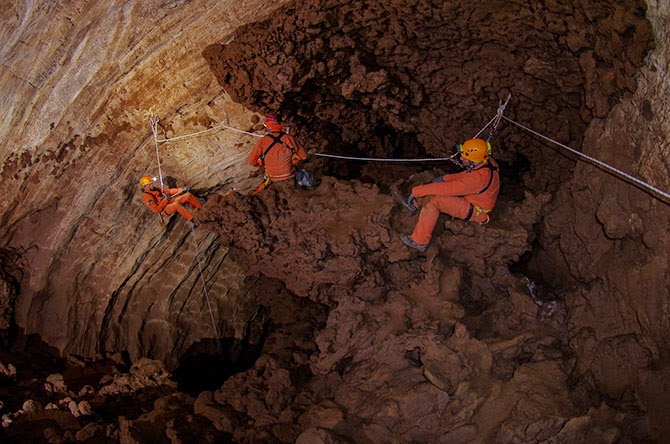 ESA astronauts practice “cavewalking”; image courtesy ESA-V. Corbu.
ESA astronauts practice “cavewalking”; image courtesy ESA-V. Corbu.
Manaugh: One of my favorite quotations is from a William S. Burroughs novel, where he describes what he calls “a vast mineral consciousness at absolute zero, thinking in slow formations of crystal.”
Boston: Oh, wow.
Manaugh: I mention that because I’m curious about how the search for “extraterrestrial life” always tends to be terrestrial, in the sense that it’s geological and it involves solid planetary formations. But what about the search for life on a gaseous planet, for example—would life be utterly different there, chemically speaking, or would it simply be sort of dispersed, or even aerosolized? I suppose I’m also curious if there could be a “cave” on a gaseous planet and, if so, would it really just be a weather system? Is a “cave” on a gaseous planet actually just a storm? Or, to put it more abstractly, can there be caves without geology?
Boston: Hmm. Yes, I think there could be. If it was enclosed or self-perpetuating.
Manaugh: Like a self-perpetuating thermal condition in the sky. It would be a sort of atmospheric “cave.”
Twilley: It would be a bubble.
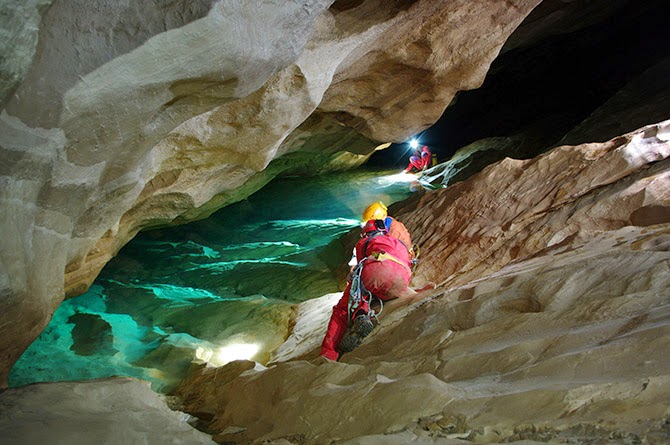 ESA astronauts explore caves in Sardinia; image courtesy ESA–R. Bresnik.
ESA astronauts explore caves in Sardinia; image courtesy ESA–R. Bresnik.
Boston: In terms of life that could exist in a permanent, fluid medium that was gaseous—rather than a compressed fluid, like water—Carl Sagan and Edwin Salpeter made an attempt at that, back in 1975. In fact, I use their “Jovian Gasbags” paper as a foundational text in my astrobiology classes.
But an atmospheric system like Jupiter is dominated—just like an ocean is—by currents. It’s driven by thermal convection cells, which are the weather system, but it’s at a density that gives it more in common with our oceans than with our sky. And we are already familiar with the fact that our oceans, even though they are a big blob of water, are spatially organized into currents, and they are controlled by density, temperature, and salinity. The ocean has a massively complex three-dimensional structure; so, too, does the Jovian atmosphere. So a gas giant is really more like a gaseous ocean I think.
Now, the interior machinations that go on in inside a planet like Jupiter are driving these gas motions. There is a direct analogy here to the fact that, on our rocky terrestrial planet, which we think of as a solid Earth, the truth is that the mantle is plastic—in fact, the Earth’s lower crust is a very different substance from what we experience up here on this crusty, crunchy top, this thing that we consider solid geology. Whether we’re talking about a gas giant like Jupiter or the mantle of a rocky planet like Earth, we are really just dealing with different regimes of density—and, here again, it’s driven by the physics.
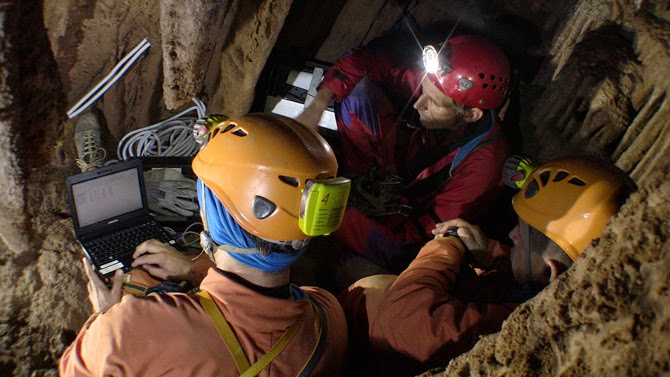 ESA astronauts set up an experimental wind-speed monitoring station in the caves of Sardinia; image courtesy ESA/V. Crobu.
ESA astronauts set up an experimental wind-speed monitoring station in the caves of Sardinia; image courtesy ESA/V. Crobu.
A couple of years ago, I sat in on a tectonics class that one of my colleagues at New Mexico Tech was giving, which was a lot of fun for me. Everybody else was thinking about Earth, and I was thinking about everything but Earth. For my little presentation in class, what I tried to do was think about analogies to things on icy bodies: to look at Europa, Titan, Enceledus, Ganymede, and so forth, and to see how they are being driven by the same tectonic processes, producing the same kind of brittle-to-ductile mantle transition, but in ice rather than rock.
I think that, as we go further and further in the direction of having to explain what we think is going on in exoplanets, it’s going to push some of the geophysics in that direction, as well. There is amazingly little out there. I was stunned, because I know a lot of planetary scientists who are thinking about this kind of stuff, but there is a big gulf between Earth geophysics and applying those lessons to exoplanets.
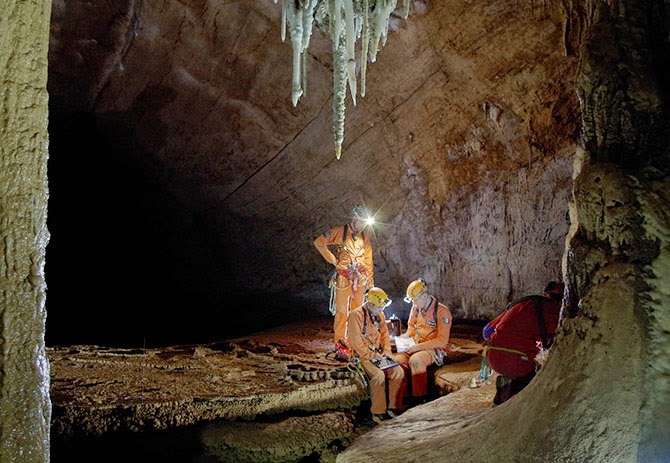 ESA astronauts prepare for their 2013 training mission in the caves of Sardinia; image courtesy ESA-V. Crobu.
ESA astronauts prepare for their 2013 training mission in the caves of Sardinia; image courtesy ESA-V. Crobu.
Manaugh: We need classes in speculative geophysics.
Boston: Yeah—come on, geophysicists! [laughs] Why shouldn’t they get in the game? We’ve been doing it in astrobiology for a long time.
In fact, when I’ve asked my colleagues certain questions like, “Would we even get orogeny on a three Earth-mass planet?” They are like, “Um… We don’t know.” But you know what? I bet we have the equations to figure that out.
It starts with something as simple as that: in different or more extreme gravitational regimes, could you have mountains? Could you have caves? How could you calculate that? I don’t know the answer to that—but you have to ask it.
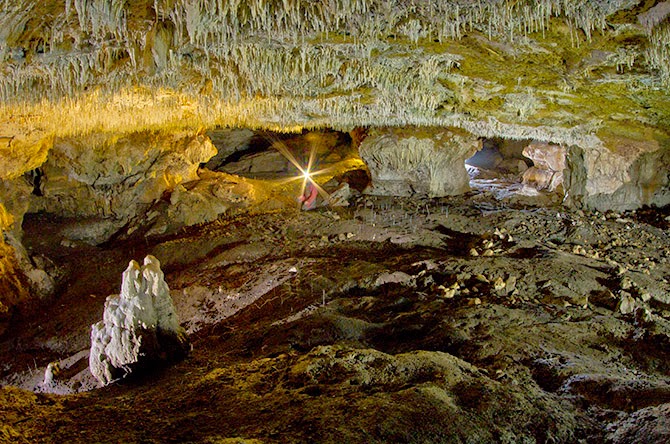 ESA astronauts take microbiological samples during a 2011 training mission in the caves of Sardinia; image courtesy of the ESA.
ESA astronauts take microbiological samples during a 2011 training mission in the caves of Sardinia; image courtesy of the ESA.
Twilley: You’re a member of NASA’s Planetary Protection Subcommittee. Could you talk a little about what that means? I’m curious whether the same sorts of planetary protection protocols we might use on other planets, like Mars, should also be applied to the Earth’s subsurface. How do we protect these deeper ecosystems? How do we protect deeper ecosystems on Mars, assuming there are any?
Boston: That’s a great question. We are working extremely hard to do that, actually.
Planetary protection is the idea that we must protect Earth from off-world contaminants. And, of course, vice versa: we don’t want to contaminate other planets—both for scientific reasons and, at least in my case, for ethical reasons—with biological material from Earth.
In other words, I think we owe it to our fellow bodies in the solar system to give them a chance to prove their biogenicity or not, before humans start casually shedding our skin cells or transporting microbes there.
That’s planetary protection, and it works both ways.
One thing I have used as a sales pitch in some of my proposals is the idea that we are attempting to become more and more noninvasive in our cave exploration, which is very hard to do. For example, we have pushed all of our methods in the direction of using miniscule quantities of sample. Most Earth scientists can just go out and collect huge chunks of rock. Most biologists do that, too. You grow E. coli in the lab and you harvest tons of it. But I have to take just a couple grams of material—on a lucky day—sometimes even just milligrams of material, with very sparse bio density in there. I have to work with that.
What this means is that the work we are doing also lends itself really well to developing methods that would be useful on extraterrestrial missions.
In fact, we are pushing in the direction of not sampling at all, if we can. We are trying to see what we can learn about something before we even poke it. So, in our terrestrial caving work, we are actually living the planetary protection protocol.
We are also working in tremendously sensitive wilderness areas and we are often privileged enough to be the only people to get in there. We want to minimize the potential contamination.
That said, of course, we are contaminant sources. We risk changing the environment we’re trying to study. We struggle with this. I struggle with it physically and methodologically. I struggle with it ethically. You don’t want to screw up your science and inadvertently test your own skin bugs.
I’d say this is one of those cases where it’s not unacceptable to have a nonzero risk—to use a double negative again. There are few things in life that I would say that about. Even in our ridiculous risk-averse culture, we understand that for most things, there is a nonzero risk of basically anything. There is a nonzero risk that we’ll be hit by a meteorite now, before we are even done with this interview. But it’s pretty unlikely.
In this case, I think it’s completely unacceptable to run much of a risk at all.
That said, the truth is that pathogens co-evolve with their hosts. Pathogenesis is a very delicately poised ecological relationship, much more so than predation. If you are made out of the same biochemistry I’m made of, the chances are good that I can probably eat you, assuming that I have the capability of doing that. But the chances that I, as a pathogen, could infect you are miniscule. So there are different degrees of danger.
There is also the alien effect, which is well known in microbiology. That is that there is a certain dose of microbes that you typically need to get in order for them to take hold, because they are coming into an area where there’s not much ecological space. They either have to be highly pre-adapted for whatever the environment is that they land in, or they have to be sufficiently numerous so that, when they do get introduced, they can actually get a toehold.
We don’t really understand some of the fine points of how that occurs. Maybe it’s quorum sensing. Maybe it’s because organisms don’t really exist as single strains at the microbial level and they really have to be in consortia—in communities—to take care of all of the functions of the whole community.
We have a very skewed view of microbiology, because our knowledge comes from a medical and pathogenesis history, where we focus on single strains. But nobody lives like that. There are no organisms that do that. The complexity of the communal nature of microorganisms may be responsible for the alien effect.
So, given all of that, do I think that we are likely to be able to contaminate Mars? Honestly, no. On the surface, no. Do I act as if we can? Yes—absolutely, because the stakes are too high.
Now, do I think we could contaminate the subsurface? Yes. You are out of the high ultraviolet light and out of the ionizing radiation zone. You would be in an environment much more likely to have liquid water, and much more likely to be in a thermal regime that was compatible with Earth life.
So you also have to ask what part of Mars you are worried about contaminating.
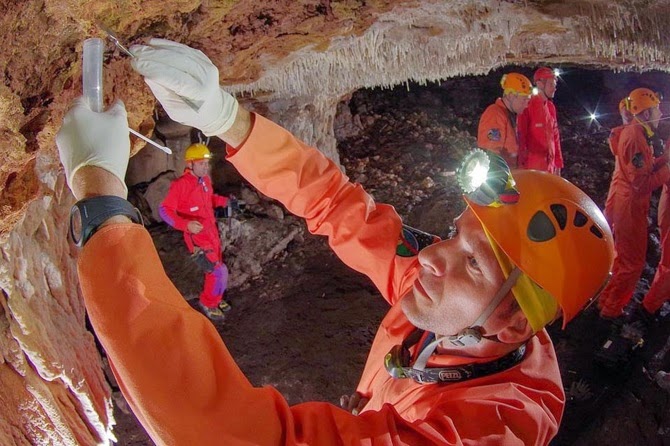
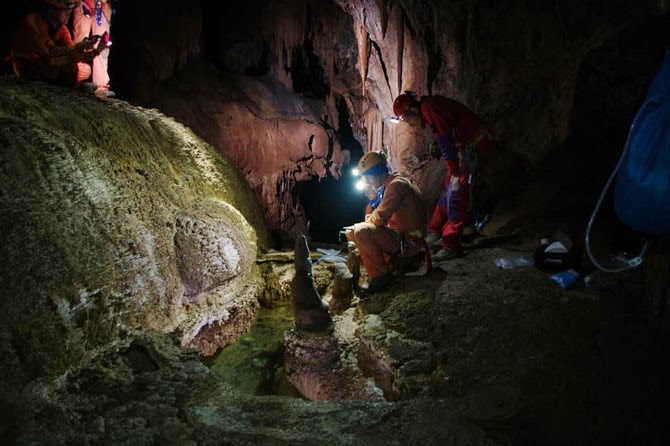 ESA teams perform bacterial sampling and examine a freshwater supply; top photo courtesy ESA–V. Crobu; bottom courtesy ESA/T. Peake.
ESA teams perform bacterial sampling and examine a freshwater supply; top photo courtesy ESA–V. Crobu; bottom courtesy ESA/T. Peake.
Manaugh: There’s been some interesting research into the possibility of developing new pharmaceuticals from these subterranean biospheres—or even developing new industrial materials, like new adhesives. I’d love to know more about your research into speleo-pharmacology or speleo-antibiotics—drugs developed from underground microbes.
Boston: It’s just waiting to be exploited. The reasons that it has not yet been done have nothing to do with science and nothing to do with the tremendous potential of these ecosystems, and everything to do with the bizarre and not very healthy economics of the global drug industry. In fact, I just heard that someone I know is leaving the pharmaceutical industry, because he can’t stand it anymore, and he’s actually going in the direction of astrobiology.
Really, there is a de-emphasis on drug discovery today and more of an emphasis on drug packaging. It is entirely profit-driven motive, which is distasteful, I think, and extremely sad. I see a real niche here for someone who doesn’t want to become just a cog in a giant pharmaceutical company, someone who wants to do a small start-up and actually do drug discovery in an environment that is astonishingly promising.
It’s not my bag; I don’t want to develop drugs. But I see our organisms producing antibiotics all the time. When we grow them in culture, I can see where some of them are oozing stuff—pink stuff and yellow stuff and clear stuff. And you can see it in nature. If you go to a lava tube cave, here in New Mexico, you see they are doing it all the time.
A lot of these chemistry tests screen for mutagenic activity, chemogenic activity, and all of the other things that are indications of cancer-fighting drugs and so on, and we have orders of magnitude more hits from cave stuff than we do from soils. So where is everybody looking? In soils. Dudes! I’ve got whole ecosystems in one pool that are different from an ecosystem in another pool that are less than a hundred feet apart in Lechuguilla Cave! The variability—the non-homogeneity of the subsurface—vastly exceeds the surface, because it’s not well mixed.
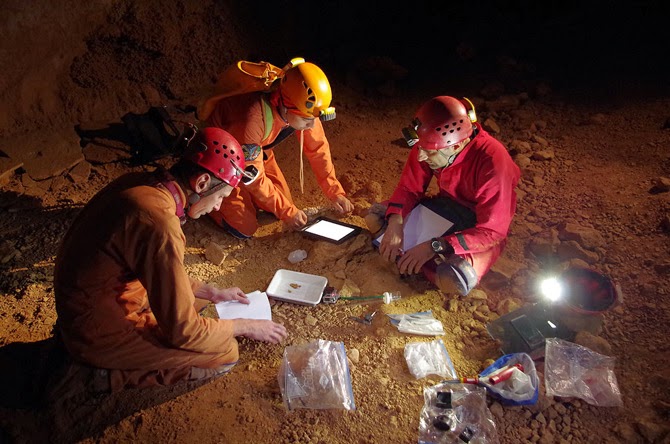 ESA astronauts prepare their experiments and gear for a 2013 CAVES (“Cooperative Adventure for Valuing and Exercising human behaviour and performance Skills”) mission in Sardinia; image courtesy ESA–V. Crobu
ESA astronauts prepare their experiments and gear for a 2013 CAVES (“Cooperative Adventure for Valuing and Exercising human behaviour and performance Skills”) mission in Sardinia; image courtesy ESA–V. Crobu
Twilley: In your TED talk, you actually say that the biodiversity in caves on Earth may well exceed the entire terrestrial biosphere.
Boston: Oh, yes—certainly the subsurface. There is a heck of a lot of real estate down there, when you add all those rock-fracture surface areas up. And each one of these little pockets is going off on its own evolutionary track. So the total diversity scales with that. It’s astonishing to me that speleo-bioprospecting hasn’t taken off already. I keep writing about it, because I can’t believe that there aren’t twenty-somethings out there who don’t want to go work for big pharma, who are fascinated by this potential for human use.
There is a young faculty member at the University of New Mexico in Albuquerque, whose graduate student is one of our friends and cavers, and they are starting to look at some of these. I’m like, “Go for it! I can supply you with endless cultures.”
Twilley: In your “Human Mission to Inner Space” experiment, you trialed several possible Martian cave habitat technologies in a one-week mission to a closed cave with a poisonous atmosphere in Arizona. As part of that, you looked into Martian agriculture, and grew what you called “flat crops.” What were they?
Boston: We grew great duckweed and waterfern. We made duckweed cookies. Gus made a rice and duckweed dish. It was quite tasty. [laughs] We actually fed two mice on it exclusively for a trial period, but although duckweed has more protein than soybeans, there weren’t enough carbohydrates to sustain them calorically.
But the duckweed idea was really just to prove a point. A great deal of NASA’s agricultural research has been devoted to trying to grow things for astronauts to make them happier on the long, outbound trips—which is very important. It is a very alien environment and I think people underestimate that. People who have not been in really difficult field circumstances have no apparent understanding of the profound impact of habitat on the human psyche and our ability to perform. Those of us who have lived in mock Mars habitats, or who have gone into places like caves, or even just people who have traveled a lot, outside of their comfort zone, know that. Your circumstances affect you.
One of the things we designed, for example, was a way to illuminate an interior subsurface space by projecting a light through fluid systems—because you’d do two things. You’d get photosynthetic activity of these crops, but you’d also get a significant amount of very soothing light into the interior space.
We had such a fabulous time doing that project. We just ran with the idea of: what you can do to make the space that a planet has provided for you into actual, livable space.
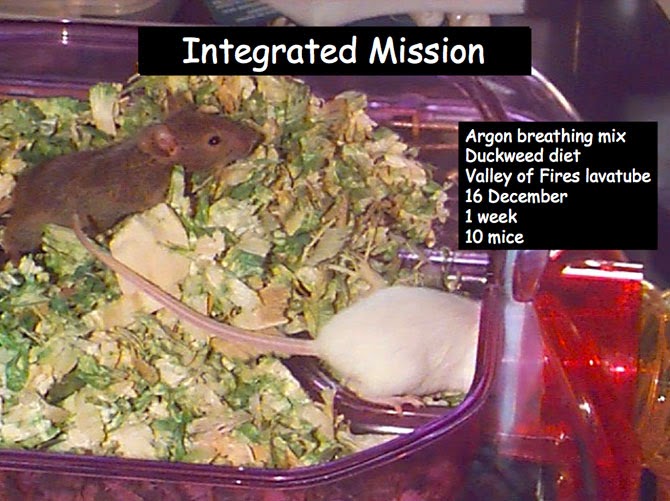 From Boston’s presentation report on the Human Utilization of Subsurface Extraterrestrial Environments, NIAC Phase II study (PDF).
From Boston’s presentation report on the Human Utilization of Subsurface Extraterrestrial Environments, NIAC Phase II study (PDF).
Twilley: Earlier on our Venue travels, we actually drove through Hanksville, Utah, where many of the Mars analog environment studies are done.
Boston: I’ve actually done two crews there. It’s incredibly effective, considering how low-fidelity it is.
Twilley: What makes it so effective?
Boston: Simple things are the most critical. The fact that you have to don a spacesuit and the incredible cumbersomeness of that—how it restricts your physical space in everything from how you turn your head to how your visual field is limited. Turning your head doesn’t work anymore, because you just look inside your helmet; your whole body has to turn, and it can feel very claustrophobic.
Then there are the gloves, where you’ve got your astronaut gloves on and you’re trying to manipulate the external environment without your normal dexterity. And there’s the cumbersomeness and, really, the psychological burden of having to simulate going through an airlock cycle. It’s tremendously effective. Being constrained with the same group of people, it is surprisingly easy to buy into the simulation. It’s not as if you don’t know you’re not on Mars, but it doesn’t take much to make a convincing simulation if you get those details right.
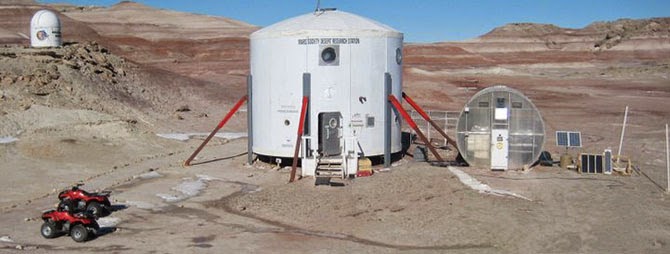 The Mars Desert Research Station, Hanksville, Utah; image courtesy of bandgirl807/Wikipedia.
The Mars Desert Research Station, Hanksville, Utah; image courtesy of bandgirl807/Wikipedia.
I guess that’s what was really surprising to me, the first time I did it: how little it took to be transform your human experience and to really cause you to rethink what you have to do. Because everything is a gigantic pain in the butt. Everything you know is wrong. Everything you think in advance that you can cope with fails in the field. It is a humbling experience, and an antidote to hubris. I would like to take every engineer I know that works on space stuff—
Twilley: —and put them in Hanksville! [laughter]
Boston: Yes—seriously! I have sort of done that, by taking these loafer-wearing engineers—most of whom are not outdoorsy people in any way, who haunt the halls of MIT and have absorbed the universe as a built environment—out to something as simple as the lava tubes. I could not believe how hard it was for them. Lava tubes are not exactly rigorous caving. Most of these are walk-in, with only a little bit of scrambling, but you would have thought we’d just landed on Mars. It was amazing for some of them, how totally urban they are and how little experience they have of coping with a natural space. I was amazed.
I actually took a journalist out to a lava tube one time. I think this lady had never left her house before! There’s a little bit of a rigorous walk over the rocks—but it was as if she had never walked on anything that was not flat before.
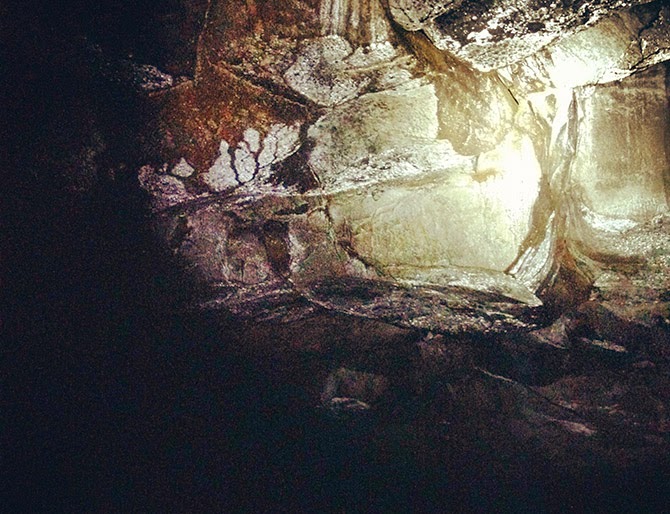
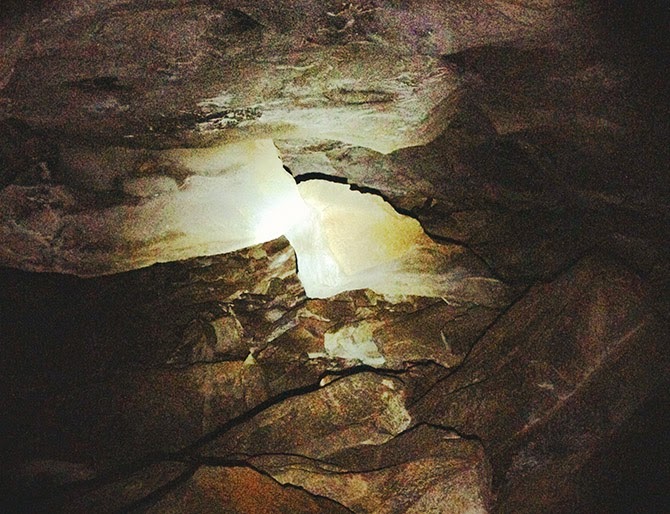 From Venue’s own visit to a lava tube outside Flagstaff, AZ.
From Venue’s own visit to a lava tube outside Flagstaff, AZ.
It’s just amazing what one’s human experience does. This is why I think engineers should be forced to go out into nature and see if the systems they are designing can actually work. It’s one of the best ways for them to challenge their assumptions, and even to change the types of questions they might be asking in the first place.
(This interview was previously published on Venue).
Architecture-by-Bee and Other Animal Printheads
 [Image: By John Becker].
[Image: By John Becker].
For thousands of years, animal bodies have been used as living 3D printers—or sentient printheads, we might say—but the range of possible material outputs is set to change quite radically. In fact, bioengineering is rapidly making this idea—that spiders, silkworms, and honeybees, to name just a few, are already 3D printers—more than just a poetic metaphor.
Those creatures are organic examples of depositional manufacturing, and they have been domesticated and used throughout human history for specific creative ends, whether it’s to produce something as mundane as honey or silk, or something far more outlandish, including automotive plastics, military armaments, and even concrete, as we’ll see below.
Animal Printheads
Researchers in Singapore discovered several years ago, for example, that silkworms fed a chemically peculiar diet could produce colored silk, readymade for use in textiles, as if they are actually biological ink cartridges; and other examples—in which animal bodies have been temporarily tweaked or even specifically bred to produce new, economically useful materials on a semi-industrial scale—are not hard to come by.
As it happens, for example, using bees as 3D printers is quickly becoming something of an accepted artistic process and its deep incorporation into advanced manufacturing processes will not be far behind.
Perhaps the most widely seen recent exploration of the animal-as-3D-printer concept was done last year for, of all things, a publicity stunt by Dewar’s, in which the company “3D printed” a bottle of Dewar’s using nothing but specially shaped and cultivated beehives.
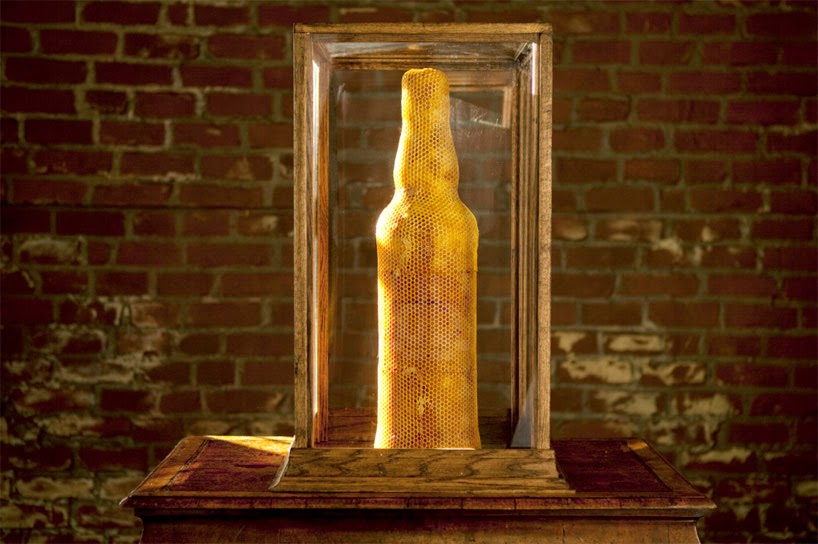
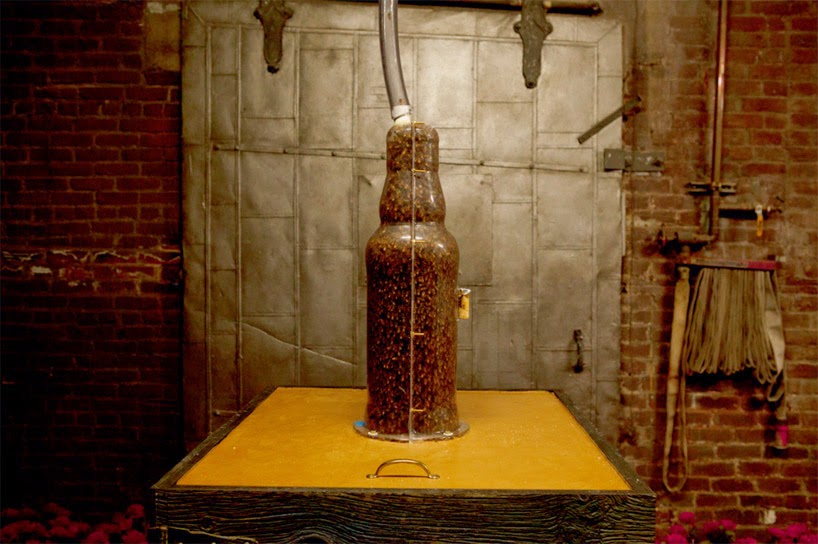 [Images: Courtesy of Dewar’s, via designboom].
[Images: Courtesy of Dewar’s, via designboom].
These pictures tell the story clearly enough: using a large glass bottle as a mold in which the bees could create new hives, the process then ended with the removal of the glass and the revealing of a complete, bottle-shaped, “3D-printed” hive.
As Dewar’s joked, it was 3B-printed.
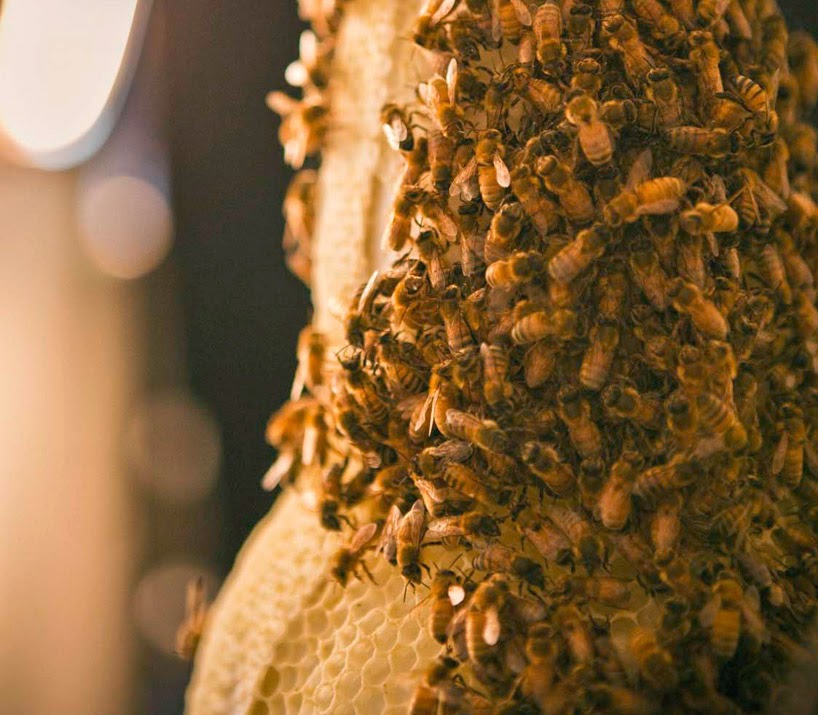
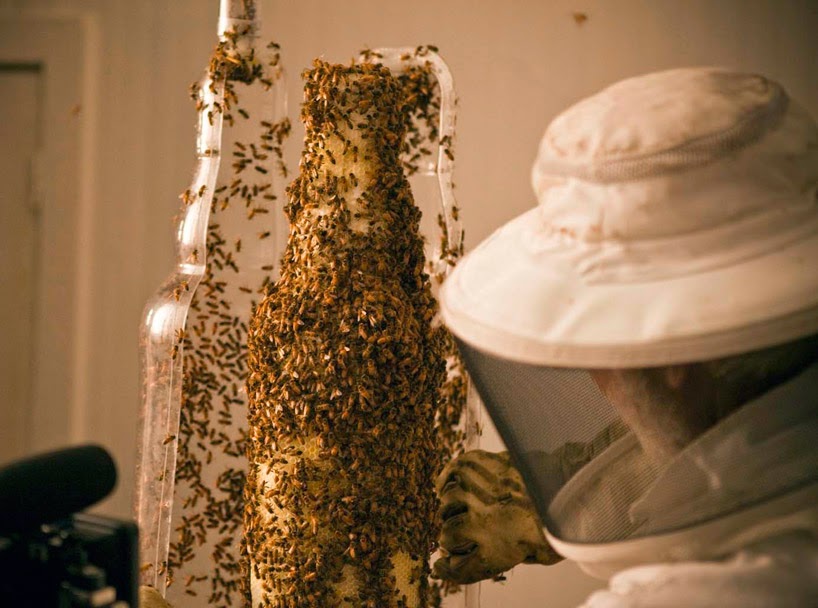
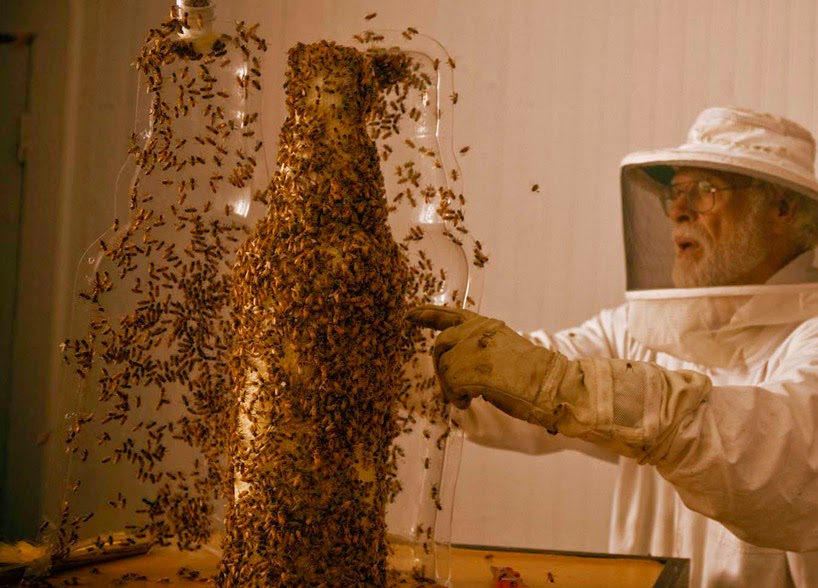 [Images: Courtesy of Dewar’s, via designboom].
[Images: Courtesy of Dewar’s, via designboom].
Or take the Silk Pavilion, another recent project you’ve undoubtedly already seen, in which researchers at MIT, led by architect Neri Oxman, 3D-printed a room-sized dome using carefully guided silkworms as living printheads.
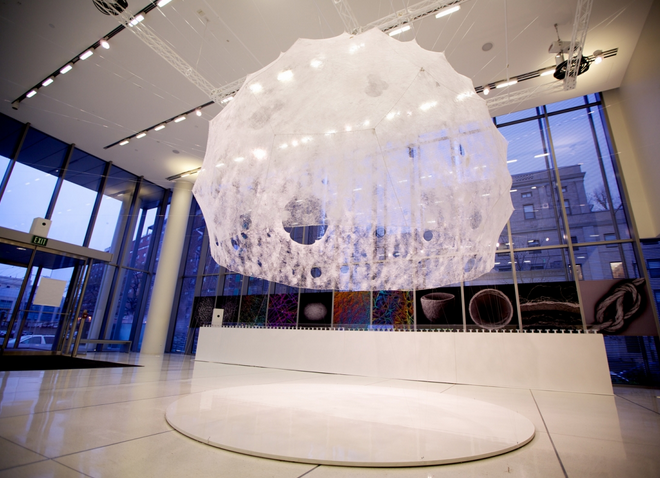 [Image: Courtesy of MIT].
[Image: Courtesy of MIT].
The Silk Pavilion was an architectural experiment in which the body of the silkworm, guided along a series of very specific paths, was “deployed as a biological printer in the creation of a secondary structure.”
The primary structure, meanwhile—the pattern used by the silkworms as a kind of depositional substrate—was nothing more than a continuous thread wrapped around a metal scaffold like a labyrinth, seen in the image below.
 [Image: Courtesy of MIT].
[Image: Courtesy of MIT].
It was at this point in the process that a “swarm of 6,500 silkworms was positioned at the bottom rim of the scaffold spinning flat non-woven silk patches as they locally reinforced the gaps across CNC-deposited silk fibers.” In other words, they infested the labyrinth and laid down architecture with their passing.
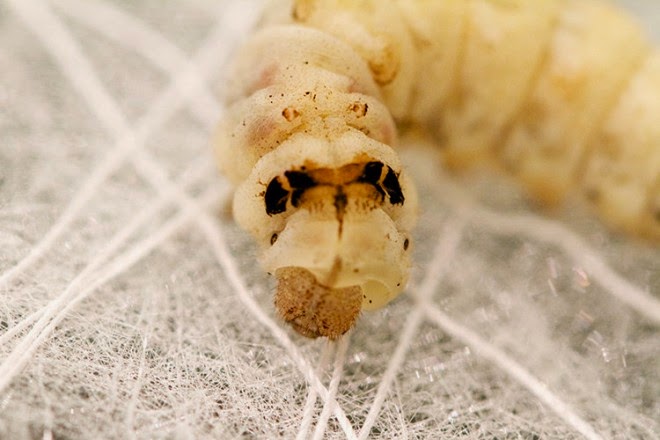 [Image: Courtesy of MIT].
[Image: Courtesy of MIT].
The “CNSilk” method, as it was known, resulted in a gossamer, woven dome that looks more like a cloud than a building.
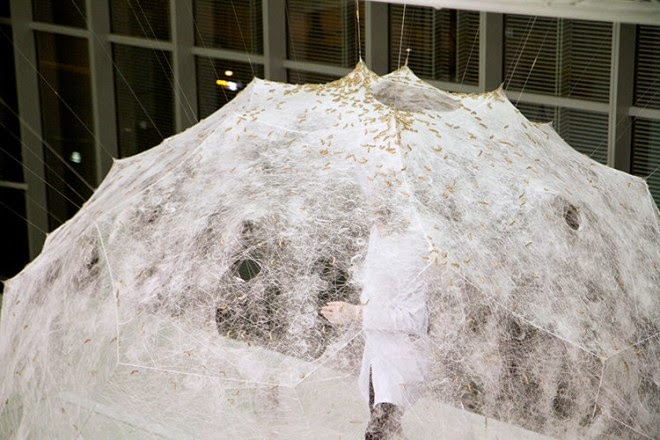
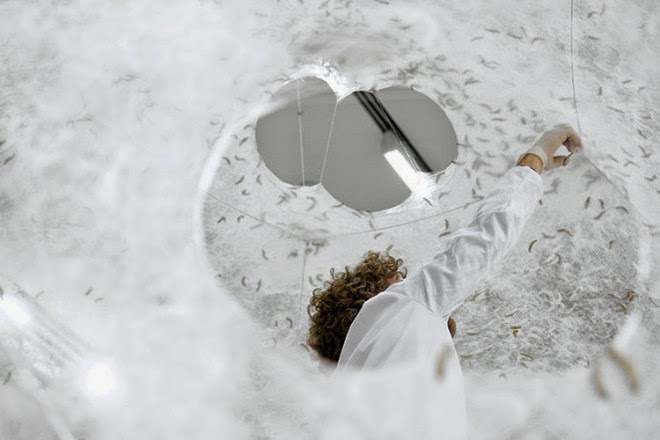 [Images: Courtesy of MIT].
[Images: Courtesy of MIT].
What both of these examples demonstrate—despite the fact that one is a somewhat tongue-in-cheek media ploy by an alcohol company—is that animal bodies can, in fact, be guided, disciplined, or otherwise regulated to produce large-scale structures, from consumer objects to whole buildings.
After all, the very origins of architecture were a collaboration with animal bodies, and experiments like these only update those earliest constructions.
In both cases, however, the animals are simply depositing, or “printing,” what they would normally (that is, naturally, in the absence of human augmentation) produce: silk and honey. Things get substantially more interesting, on the other hand, when we look at more exotic biological materials.
Bee Plastic
For half a decade or more, materials scientist Debbie Chachra at New England’s Olin College of Engineering has been researching what’s known as “bee plastic”: a cellophane-like biopolymer produced by a species native to New England, called Colletes inaequalis.
These bees secrete tiny, cocoon-like structures in the soil—one such structure can be seen in the photo, below—using a special gland unique to its species. The resulting, non-fossil-fuel-based natural polyester not only resists biodegradation, it also survives the temperate extremes of New England, from the region’s sweltering summers to its subzero winter storms.
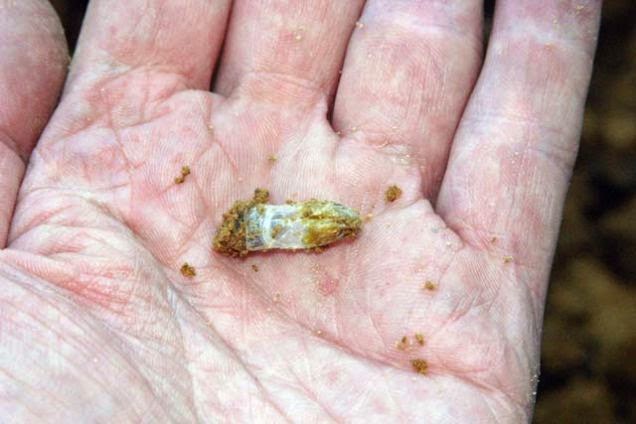 [Image: Courtesy of Deb Chachra].
[Image: Courtesy of Deb Chachra].
More intriguingly, however, the cellophane-like bee plastic “doesn’t come from petroleum,” Chachra explained to me for a 2011 end-of-year article in Wired UK. “The bees are pretty much just eating pollen and producing this plastic,” she continued, “and we’re trying to understand how they do it.”
Bee plastic, Chachra justifiably speculates, could perhaps someday be used to manufacture everything from office supplies to car bumpers, acting as an oil-free alternative to the plastics we use today. In the process, it could perhaps even kickstart a homegrown bio-industry for New England, where the species already thrives, wherein the very idea of a factory needs to be fundamentally reimagined.
The most exciting architectural possibilities here come less from the bees themselves and more from the elaborate structures that would be required to house their activities; imagine a brand new BMW factory somewhere in the suburbs of Boston populated only by plastic-producing bees, and you get some sense of where industrial manufacturing might go in an alternate future. Not unlike Dewar’s bee-printed bottle, then, augmented cousins of Chachra’s plastic-producing bees could thus 3D-print whole car bodies, kitchen counters, architectural parts, and other everyday products.
But even this, of course, is a vision of animal-based manufacturing that relies on the already-existent excretions of living creatures. Could we—temporarily putting aside the ethical implications of this, simply to discuss the material possibilities—perhaps genetically modify bees, silkworms, spiders, and so on to produce substantially more robust biopolymers, something not just strong enough to resist biodegrading but that could be produced and used on an industrial scale?
Recall, for example, that the U.S Army, working with a Canadian firm called Nexia Biotechnologies, was successful in its attempt to genetically engineer a goat that would produce spider-silk proteins in its milk. Incredibly, those “Biosteel goats,” as they were later known, were eventually housed in old ammunition bunkers on a New York State military base, as if they were living bioweapons that needed to be held in quarantine.
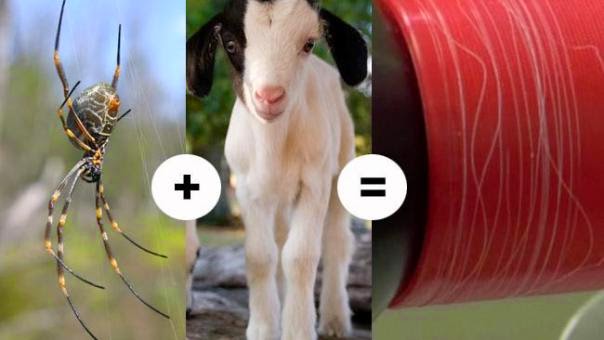 [Image: Biosteel goats summed-up in one simple equation (via)].
[Image: Biosteel goats summed-up in one simple equation (via)].
The ultimate goal of producing these goats was to generate an unbreakable super-fiber that could be used in battle gear, including “lightweight body armor made of artificial spider silk,” and other military armaments; but others have speculated that entire bridges or other pieces of urban infrastructure could someday be woven by goats.
These possibilities become even more strange and promising when we move to materials like concrete.
Concrete Honey
As part of an ongoing collaborative project, NYC-based designer John Becker and I have been looking at the possibility of using bees that have been genetically modified to print concrete. We could call them architectural printheads.
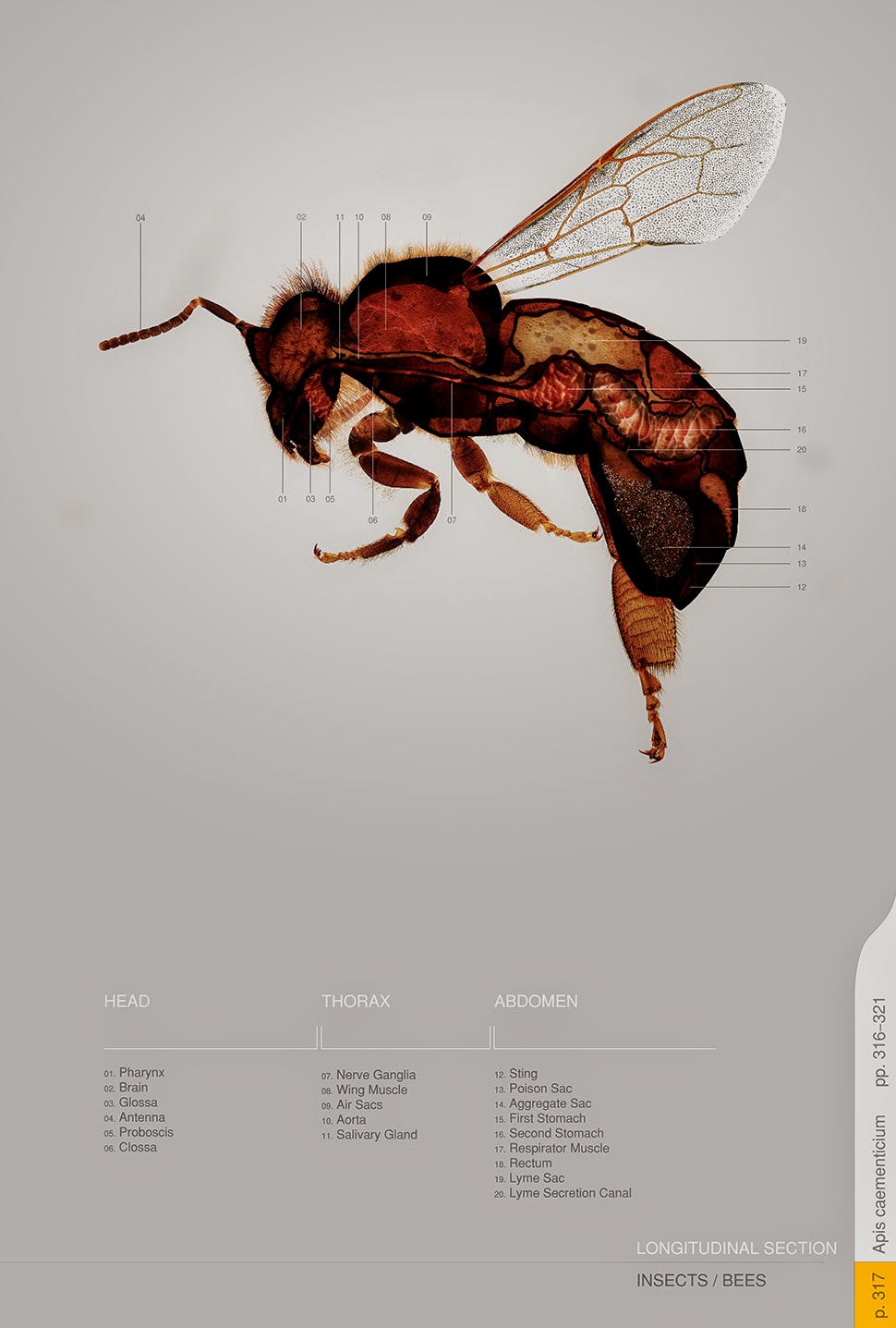 [Image: By John Becker].
[Image: By John Becker].
Initially inspired by a somewhat willful misreading of a project published under the title “Bees Make Concrete Honey,” John and I began to imagine and illustrate a series of science-fictional scenarios in which a new urban bee species, called Apis caementicium—or cement bees—could be deployed throughout the city as a low-cost way to repair statues and fix architectural ornament, even to produce whole, free-standing structures, such as cathedrals.
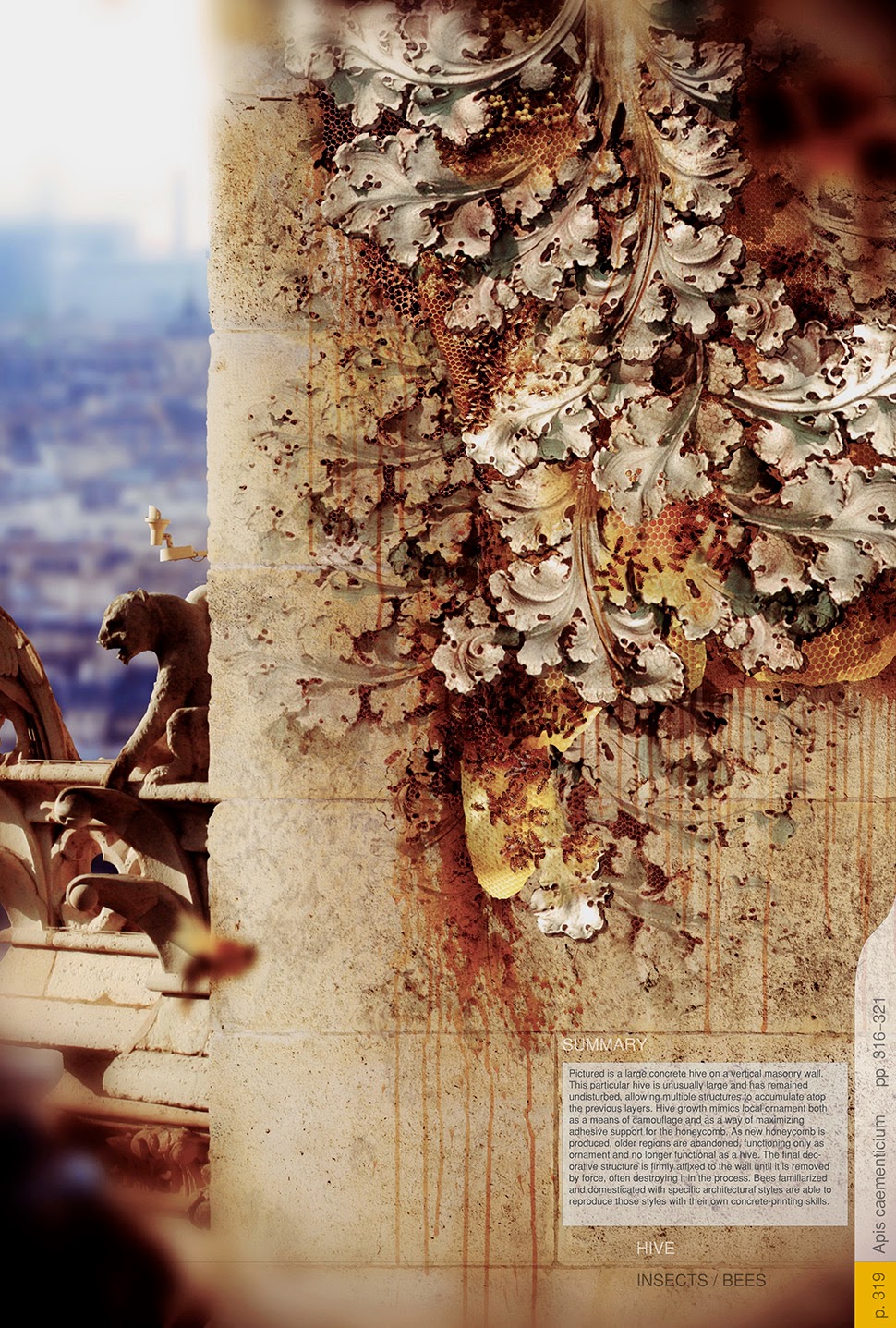 [Image: By John Becker].
[Image: By John Becker].
In a process not unlike that used for the Dewar’s bottle, above, the bees would be given an initial form to work within. Then, buzzing away inside this mold or cast, and additively depositing the ingredients for bio-concrete on the walls, frames, or structures they’ve been attached to, the bees could 3D-print new architectural forms into existence.
This includes, for example, the iconic stone lions found outside the New York Public Library; they’ve been damaged by exposure and human contact, but can now be fixed from within by concrete bees. Think this as a kind of organic caulking.
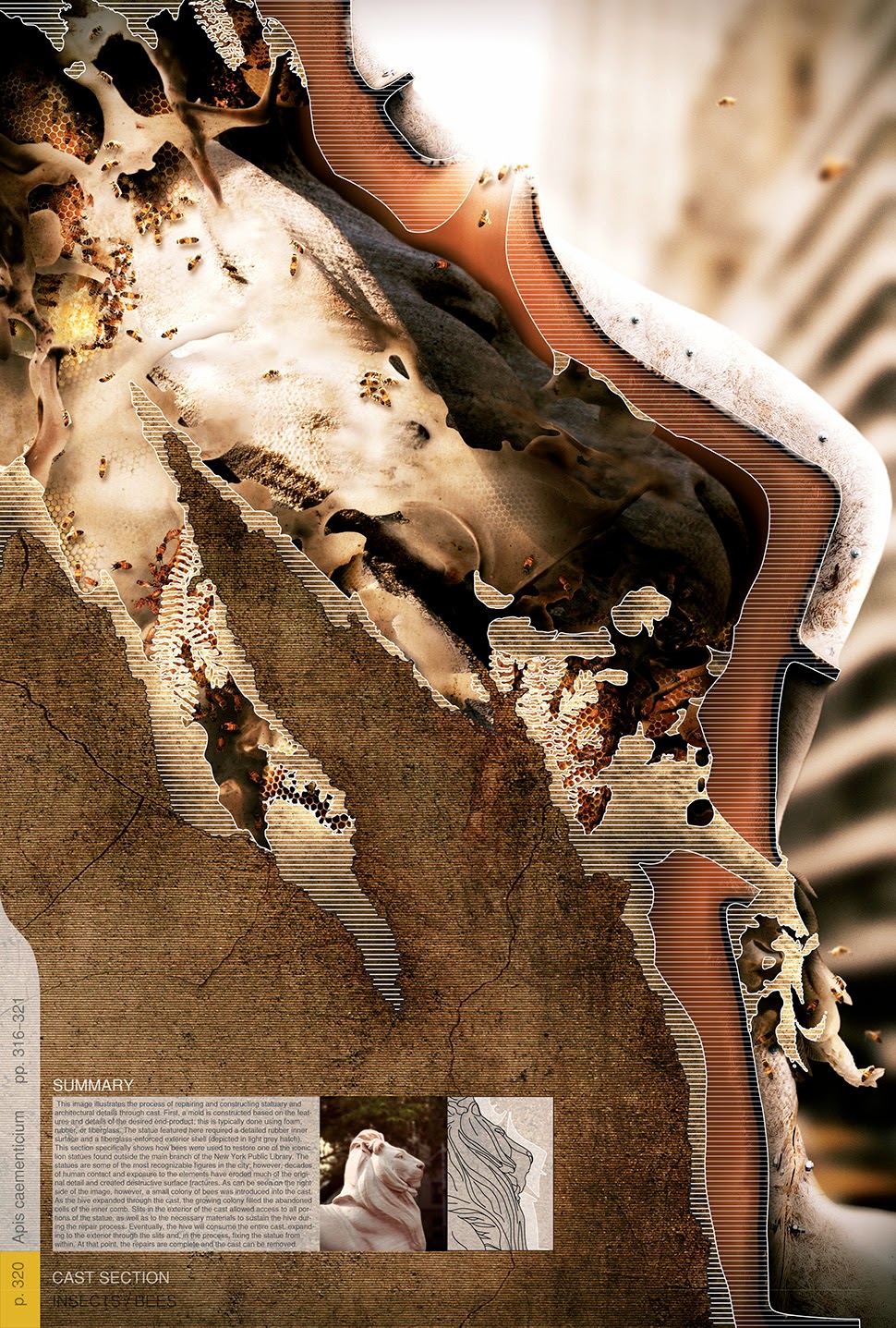 [Image: By John Becker].
[Image: By John Becker].
Yet tidy plots such as these invariably spin out of control and things don’t quite go as planned.
Feral Printers
Predictably, these concrete bees eventually escape: first just a few here and there, but then an upstart colony takes hold elsewhere in the city. They breed, speciate, and expand.
Within a few years, as the bees reproduce and thrive, and as their increasingly far-flung colonies grow, people become aware of the scale of the problem: rogue 3D-printing bees have begun to infest the region.
 [Image: By John Becker].
[Image: By John Becker].
They print where they shouldn’t print and, without the direction of their carefully made formwork and molds, what they produce often makes no sense.
They print on signs and phone poles; they take over parks and gardens where they print strange forms on flowers, sealing orchids and roses in masonry shells. Bizarre gardens of hardened geometry form on windowsills and ledges, deep in urban forests and along railways and roads.
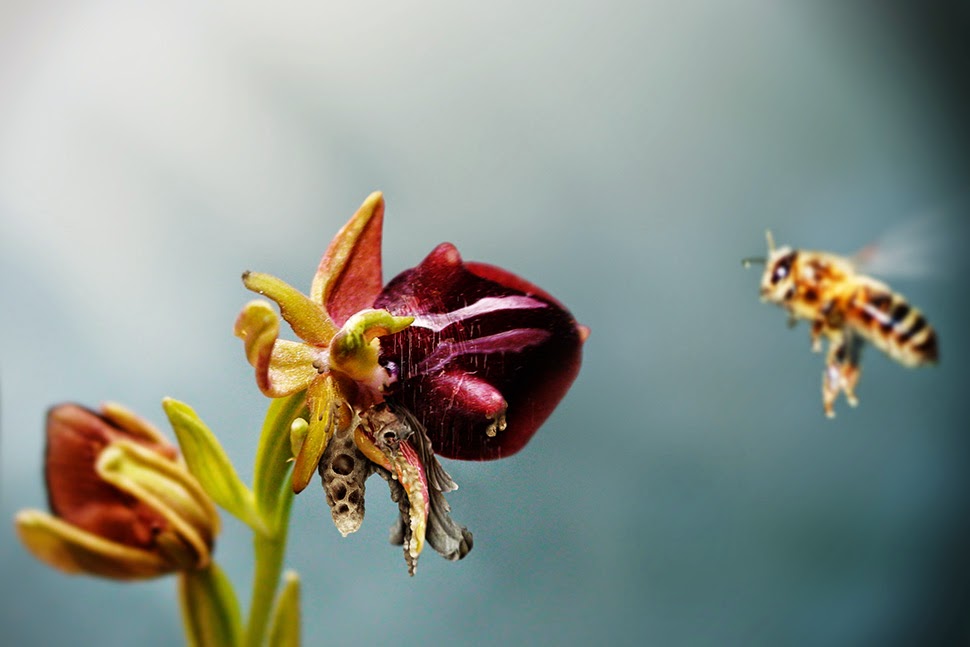 [Image: By John Becker].
[Image: By John Becker].
Tiny fragments of concrete can soon be seen atop plants and door frames, beneath cars and on chain-link fences, coiling up and consuming the sides of structures where they were never meant to be, like kudzu; and, of course, strange bee bodies are found now and again, these little concrete-laden corpses lying in the deep grass of backyards, on parking lots and rooftops.
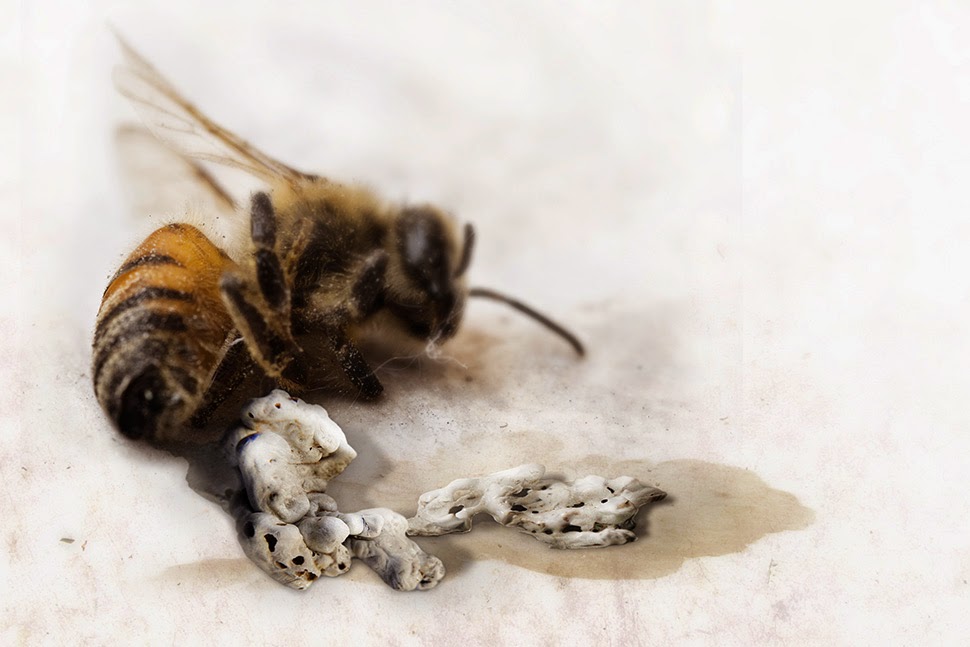 [Image: By John Becker].
[Image: By John Becker].
Their fallen bodies, augmented and extraordinary, thus dot the very city they’ve also beautified and improved—this place where they once printed church steeples and apartment ornament, where they fixed cracked statues, sidewalks, and walls.
Of course, other, more adventurous or simply disoriented bees make their way further, hitching inadvertent rides in the holds of planes and cargo ships, mistakenly joining other hives then shipped around the world.
The bees are soon found in Europe, China, and—for reasons never quite clear to materials scientists—throughout India, where, as in the sample image below, they can be seen adding unnecessary ornamentation to temples in Rajasthan. Swarming and uncountable, they busily speck the outside of the building with bulbous and tumid additions no architect would ever have planned.
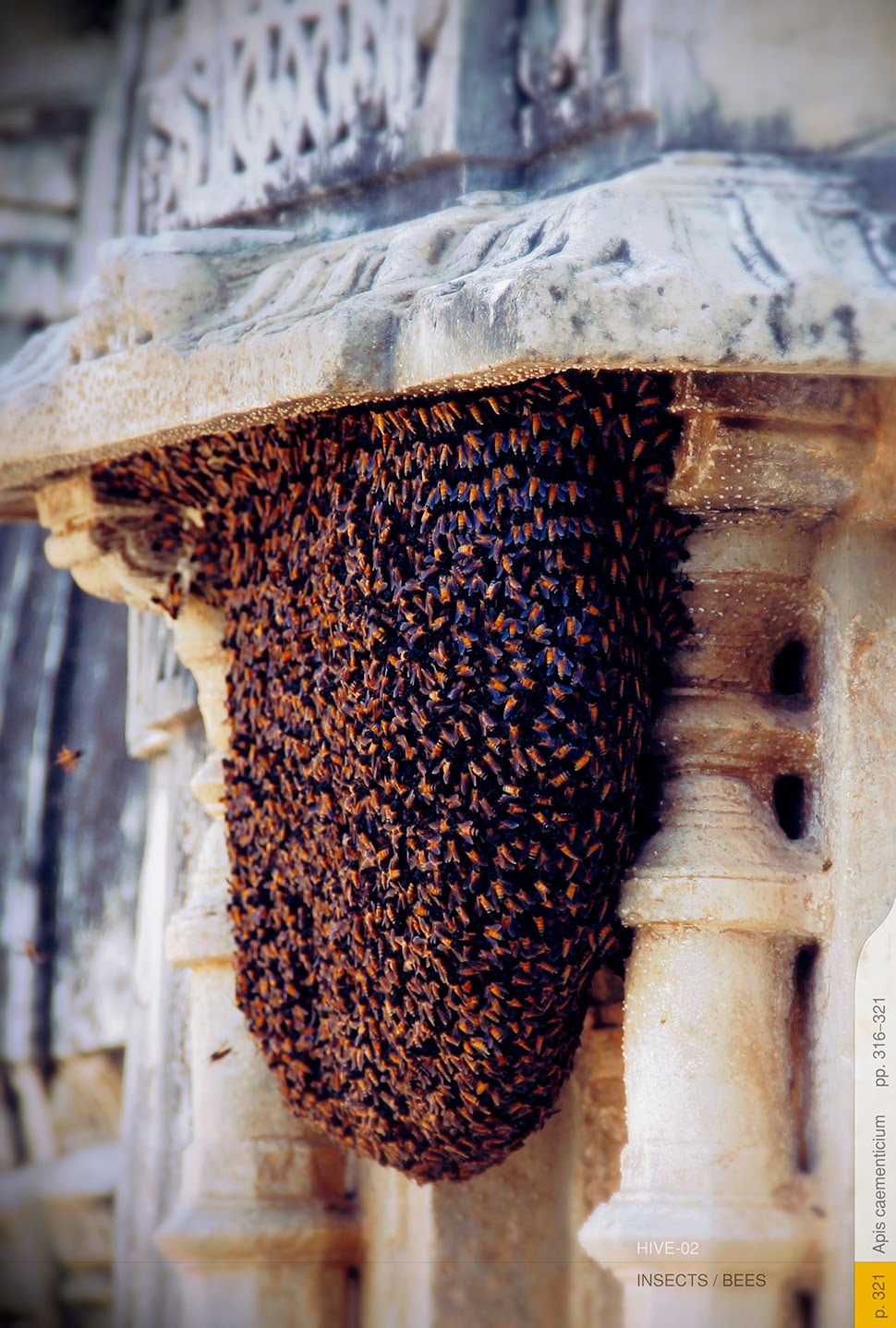 [Image: By John Becker].
[Image: By John Becker].
As the bees speciate yet further, and their concrete itself begins to mutate—in some cases, so hard it can only be removed by the toughest drills and demolition equipment, other times more like a slow-drying sandstone incapable of achieving any structure at all—this experiment in animal printheads, these living 3D printers producing architecture and industrial objects, comes to end.
A Bee Amidst The Machines
Most designers learn from the—in retrospect—obvious mistakes that led to these feral printers, returning to more easily controlled inorganic factories and industrial processes. But, even then, on quiet spring days, a tiny buzzing sound can occasionally be heard beneath someone’s front porch, out in the suburban gardens somewhere, deep inside National Parks, and even inside huge machines, where whole automobile assembly lines come shuddering to a halt.
There, within the gears, just doing what it’s used to doing—what we made it do—a tiny family of 3D-printing bees has taken root, leaving errant clumps of concrete wherever they alight.
(Thanks to John Becker for the fun. An earlier version of this post was previously published on Gizmodo).
Concrete Honey and the Printing Room
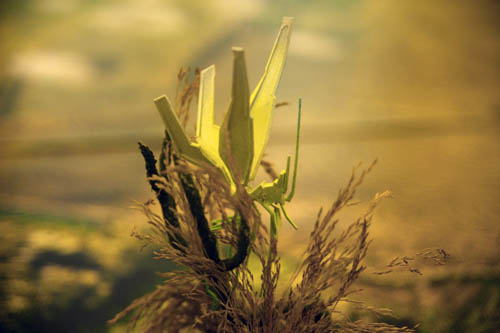 [Image: “Beamer Bees” by Liam Young and Anab Jain].
[Image: “Beamer Bees” by Liam Young and Anab Jain].
I had an interesting and long conversation last week with John Becker, one of my students at Columbia’s GSAPP, about everything from the future of 3D printers, the possibility of permanently embedding such machines into the fabric of a building, and even the genetic manipulation of nonhuman species so that they could produce new, architecturally useful materials.
A few quick things about that conversation seem worth repeating here:
1) Famously, groups like Archigram proposed using construction cranes as permanent parts of their buildings. The crane could thus lift new modular rooms into place, add whole new floors to the perpetually incomplete structure, and otherwise act as a kind of functional ornament. The crane, “now considered part of the architectural ensemble,” Archigram’s Mike Webb wrote, would simply be embedded there, “lifting up and moving building components so as to alter the plan configuration, or replacing parts that had work out with a ‘better’ product.”
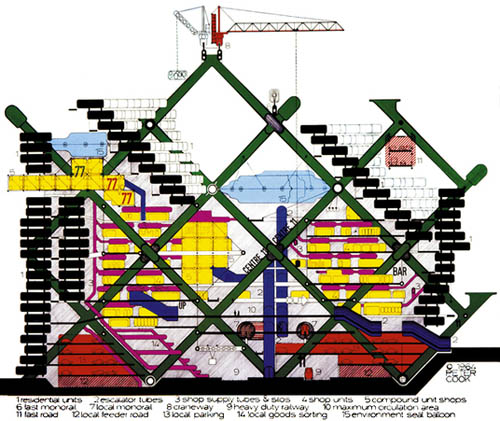 [Image: Plug-In City by Archigram/Warren Chalk, Peter Cook, Dennis Crompton; courtesy University of Westminster].
[Image: Plug-In City by Archigram/Warren Chalk, Peter Cook, Dennis Crompton; courtesy University of Westminster].
But 3D printers are the new cranes.
For instance, what if Enrico Dini’s sandstone-printing device—so interestingly profiled in Blueprint Magazine last month—could be installed somewhere at the heart of a building complex—or up on the roof, or ringed around the edge of a site—where it could left alone to print new rooms and corridors into existence, near-constantly, hooked up to massive piles of loose sand and liquid adhesives, creating infinite Knossic mazes? The building is never complete, because it’s always printing itself new rooms.
In fact, I think we’ll start to see more and more student projects featuring permanent 3D printers as part of the building envelope—and I can’t wait. A room inside your building that prints more rooms. It sounds awesome.
2) Several months ago, the Canadian Centre for Architecture, as part of their exhibition Actions: What You Can Do With the City, put up #77 in its list of things “you can do with the city”: they phrased it as Bees Make Concrete Honey.
My eyes practically fell out of my head when I saw that headline, imagining genetically modified bees that no longer produce honey, they produce concrete. They’d mix some strange new bio-aggregate inside their bellies. Instead of well-honeyed hives, you’d have apian knots of insectile concrete. Perhaps they could even print you readymade blocks of ornament: florid scrolls and gargoyle heads, printed into molds by a thousand bees buzzing full of concrete. Bee-printers.
Alas, it had nothing to do with apian concrete; it was simply a play on words: urban bees make urban honey… or concrete honey, if you want to be poetic. But no matter: using bees to create new forms of concrete—perhaps even new forms of sandstone (whole new geologies!)—is ethically horrific but absolutely extraordinary. After all, there are already bugs genetically modified to excrete oil, and even goats that have been made to produce spider silk.
What, though, are the architectural possibilities of concrete honey?
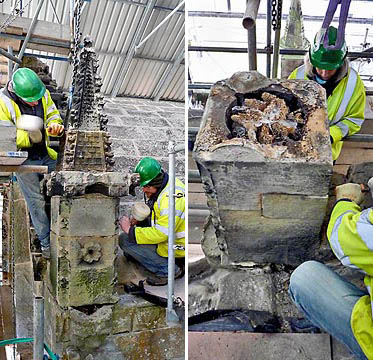 [Images: The Rosslyn Chapel hives; photos courtesy of the Times].
[Images: The Rosslyn Chapel hives; photos courtesy of the Times].
3) Last month, over at Scotland’s Rosslyn Chapel, it was announced that “builders renovating the 600-year-old chapel have discovered two beehives carved within the stonework high on the pinnacles of the roof. They are thought to be the first man-made stone hives ever found.”
It appears the hives were carved into the roof when the chapel was built, with the entrance for the bees formed, appropriately, through the centre of an intricately carved stone flower. The hives were found when builders were dismantling and rebuilding the pinnacles for the first time in centuries.
As the article goes on to point out, “Although human beings have collected honey from wild bee colonies since time immemorial, at some point they began to domesticate wild bees in artificial hives, made from hollow logs, pottery, or woven straw baskets. The Egyptians kept bees in cylindrical hives, and pictures in temples show workers blowing smoke into the hives, and removing honeycombs. Sealed pots of honey were found in Tutankhamun’s tomb.”
But, combining all these stories, what about bees that make concrete honey, artificially bred and housed inside hives in the spires of buildings? Hives that they themselves have printed?
High up on the roof of St. John the Divine sit six symmetrical stone hives, inside of which special bees now grow, tended by an architecture student at Columbia University; the bees are preparing their concrete to fix any flaw the building might have. No longer must you call in repair personnel to do the job; you simply tap the sides of your concrete-mixing beehives and living 3D printers fly out in a buzzing cloud, caulking broken arches and fixing the most delicate statuary.
Nearby homeowners occasionally find lumps of concrete on their rooftops and under the eaves, as if new hives are beginning to form.
4) In the opening image of this post, you see the so-called “Beamer Bees” that Liam Young, Anab Jain, and collaborators created for Power of 8. The beamer bees were “formulated by a community of biologists and hired bio-hackers to service under-pollinated trees, plants and vegetables due to the disappearance of honey bees.” And while the beamers don’t actually have much to do with the idea of mobile 3D-printing swarms, any post about designing with bees would be incomplete without them…
(Thanks to Steve Silberman for the Rosslyn Chapel hives link, and to John Becker for the conversation these ideas came from).
Plants Without Borders: An Interview with Sara Redstone
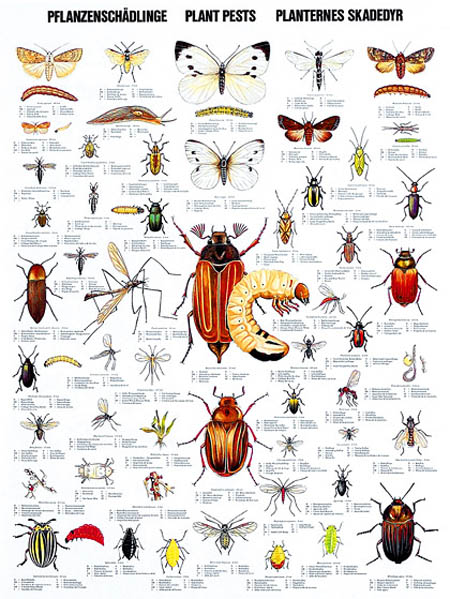 [Image: 55 of Europe’s most common plant pests in a wall poster found via the Scandinavian Fishing Year Book].
[Image: 55 of Europe’s most common plant pests in a wall poster found via the Scandinavian Fishing Year Book].
Sara Redstone is Plant Health and Quarantine Officer for the Royal Botanic Gardens at Kew, home of the world’s largest collection of living plants. In addition to screening and isolating all incoming or outbound plant material, she is currently overseeing the design and construction of a new quarantine facility for the gardens.
As part of our ongoing series of quarantine-themed interviews, Nicola Twilley of Edible Geography and I visited Redstone at Kew, where we drank tea outside the Orangery café. Over the course of nearly two hours, we talked about the impact of current and potential pest outbreaks, the ecological risks of open E.U. borders and global trade, and the complicated governmental infrastructure of plant protection. In addition, we touched on what plant quarantine at Kew actually looks like, in terms of the functional and technical challenges involved in Wilkinson Eyre Architects‘ design for a new Quarantine House. Along the way, we covered plant smuggling, invasive species, and the potential to create a Sudden Oak Death super-strain.
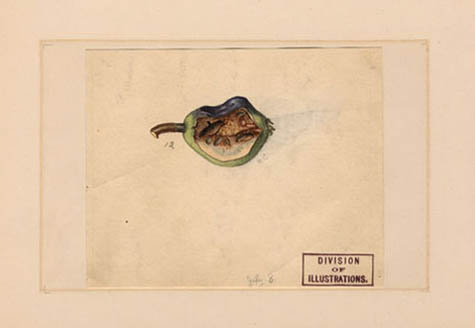 [Image: A diseased pear from the USDA Pomological Watercolor Collection].
[Image: A diseased pear from the USDA Pomological Watercolor Collection].
• • •
BLDGBLOG: What do plant quarantine measures encompass—invasive species, plant diseases, or even genetically modified organisms? And who is in charge of enforcing plant quarantine in the UK?
Sara Redstone: Plant quarantine at the Royal Botanic Gardens, Kew, is concerned with controlling plant pests and diseases, to protect our living collections and the wider environment. In the UK, a number of different structures govern plant import restrictions, monitor invasives, and issue licenses for quarantine and for genetically-modified organism—GMO—research. The rules for working with GMOs are laid out and policed by the Health and Safety Executive, but issues that relate to plant health, quarantine, and potential pests and diseases of plants are actually monitored and controlled by an organization called FERA (the Food and Environment Research Agency), which is a new agency within DEFRA (the Department for Environment, Food and Rural Affairs).
It can get quite complicated! Different organizations deal with plant health issues depending on where the plants grow and what they are. Unfortunately, the type of information you can get online relating to plant health and quarantine is not always very user-friendly. For example, inquiries about plant health, imports, and restrictions in Scotland go to the Scottish Office, but in England they either go to FERA or the Forestry Commission, depending on the type of organism. Licenses to operate quarantine facilities depend on what type of material you are quarantining (plant or animal), the purpose of raising such material (to grow the plant itself or to grow potential pests or diseases), and various other factors. Meanwhile, GMOs fall under the Health and Safety Executive, as I said—but inquiries about GMO regulations go to DEFRA.
Ordinary members of the public quite understandably find this very confusing.
Edible Geography: What are some of the most worrying issues facing you in terms of plant pest control?
Redstone: One particularly nasty tree pest, which is also a potential human health hazard, is the Oak Processionary Moth. Kew is just one of many locations in southwest London that has experienced this pest. Like the Browntail and other moths, during various stages of their life-cycle the caterpillars are covered in really brittle hairs that have a toxin in them. It can give you a nasty rash and may cause breathing difficulties or affect your eyes on contact.
The moth came into the UK as eggs on imported trees from Holland—and the challenge we face is that we don’t typically quarantine trees from northern Europe. There is no legal requirement to quarantine material from within the EU, but the pest is widespread in the Benelux countries and in Germany, and it is increasing its range on the mainland.
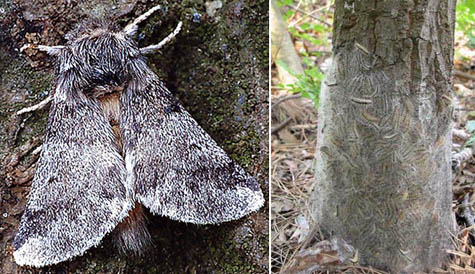 [Images: (left) The Oak Processionary Moth, pictured in a 2007 Daily Mail article titled: “Gardeners are mercilessly hunting down moths with hairspray and flame-throwers.” (right) Tree infested with Oak Processionary Moth caterpillars. Photo taken by Ferenc Lakatos, University of West-Hungary; found via the Centre for Invasive Species and Ecosystem Health’s Bugwood Network].
[Images: (left) The Oak Processionary Moth, pictured in a 2007 Daily Mail article titled: “Gardeners are mercilessly hunting down moths with hairspray and flame-throwers.” (right) Tree infested with Oak Processionary Moth caterpillars. Photo taken by Ferenc Lakatos, University of West-Hungary; found via the Centre for Invasive Species and Ecosystem Health’s Bugwood Network].
What happens is that many Dutch, Belgian, and German nurseries raise trees and shrubs in southern Europe, in areas such as Italy, where the Oak Processionary Moth is already established. The climate and local conditions promote better growth than can be achieved in northern areas, so you get bigger plants faster. They then move the plants back north to grow them on the nursery for a period of time, to get the right shape, etc. This kind of movement of plants has resulted in a lot of pests increasing their range and moving northwards.
Once a pest is established in a those northern mainland European states, there’s no way to prevent it from spreading to the others—because there are no real boundaries. There are no geographic features that are going to prevent them from moving, and there are no trade barriers that are going to stop them, either.
Although Britain is an island, everything is very much geared toward free trade; unfortunately, quarantine is usually secondary to trade. Most people involved in pest & disease control and quarantine will tell you that we like to employ what we call “the precautionary principle”—but, for political and economic reasons, governments don’t always choose to operate that way.
One of my concerns is that we know about these tree movements on the European mainland, and we know that the Citrus Long-horned Beetle, for instance, is now fairly well established in the Lombardy district in Italy—which is not that far from some of the major tree-growing areas in Tuscany. But what’s going to prevent those Long-horneds from spreading to northern Europe, given the movement of plants, and then coming over to the UK?
We’ve already had an instance where infested Acers were grown in China, shipped over to mainland Europe, and then sold in the UK. The beetle has a long larval phase—two to three years when it is undetectable by normal means, though I understand stethoscopes are now being used by some plant inspectors in an effort to detect larvae feeding. Usually the only way to detect them is finding the emergence hole in the tree base—or finding the adult beetle, after the fact. Were all the infested trees found? Were all the beetles present in the consignment destroyed? We don’t even know where all those plants have gone. It’s really bad news.
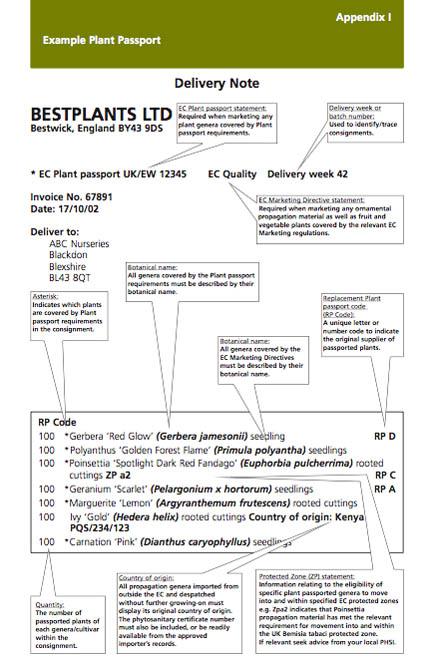 [Image: Sample “Plant Passport” from DEFRA’s Plant Health Guide to Plant Passporting].
[Image: Sample “Plant Passport” from DEFRA’s Plant Health Guide to Plant Passporting].
BLDGBLOG: What sort of measures are in place to deal with these threats?
Redstone: Material that comes in from the European Union is generally uncontrolled. There are “Plant Passport” regulations that apply to certain types of plant, but there’s no record of exactly what plant material is moving and where it’s from.
For instance, even if it says it is from, say, Holland, it doesn’t mean that that material originated in Holland. It may have arrived via Holland in a container ship from China.
Different countries have different standards for quarantine and plant health. You can understand that, in some countries where it’s really a struggle to make a living, different rules apply. There is an organization called the International Plant Protection Committee (IPPC), which makes recommendations—but there is a real lack of shared standards for plant quarantine.
One thing that would be really useful now would be a series of suggested blueprints for quarantine buildings. For example, quarantine houses in places like the tropics can be relatively simple: mesh-screen, poly-tunnel-type structures with restricted access are fine. You don’t always have to use chemicals to sterilize things—in the tropics, you can use heat. Even in the UK, we can quite often use solar gain in our glasshouses to sterilize an area, provided we know what we’re trying to kill. The same methods have been used for years in agriculture; farmers will put polythene over an area of land, and then rely on the sun to sterilize the soil.
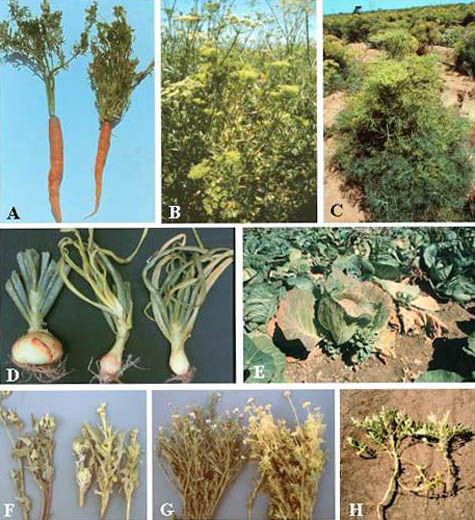 [Image: Healthy and diseased plants in a side-by-side comparison, via the USDA Agricultural Research Service].
[Image: Healthy and diseased plants in a side-by-side comparison, via the USDA Agricultural Research Service].
Edible Geography: Here at Kew, what is it that you are quarantining? Why does Kew need a quarantine house?
Redstone: We use plant quarantine—isolating, screening, and treating plants—for incoming and outgoing plants where we’ve determined they may be a risk associated with their movement. For example, if we want to repatriate material to a country as part of a conservation project, the last thing we would want to do is inadvertently introduce a new pest or disease; so we isolate and treat plants before moving them, to reduce that risk to an absolute minimum.
At present we’re in the process of planning a new quarantine facility. Our intention with the new building is that all plant material that is sent to Kew and to our sister-garden, Wakehurst Place in Sussex, will come to this one point—our new “plant reception”—regardless of its origin. This means we can improve our data capture; we can make sure that all incoming material is compliant with the necessary legislation; we can do an initial inspection; and, if we think there’s a risk, we can also do the isolation and screening.
England is not like the United States, where the USDA maintains the plant quarantine service. If, say, the New York Botanical Garden requests plant material from us, they will send us an import permit and shipping labels, and the labels will direct those materials to the USDA quarantine service, who then send the material on. But we operate quite a different system in the UK and European Union.
What happens here at Kew is that we have a licensed quarantine facility, which is approved by FERA and licensed by DEFRA. This gives us the ability to quarantine plant imports that come to the gardens from outside the European Union.
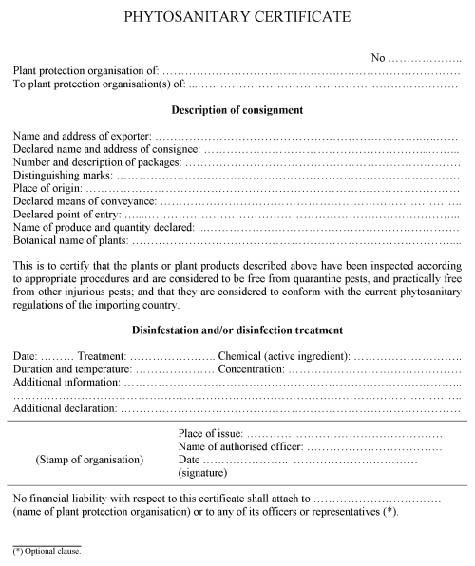 [Image: UK Phytosanitary Certificate, via the Plant Health (England) Order (2005)].
[Image: UK Phytosanitary Certificate, via the Plant Health (England) Order (2005)].
These usually fall into two main types. One is the type of material that comes in with a phytosanitary certificate.
If, for example, somebody went to Costa Rica and they wanted to bring back material from a botanic garden there, they would arrange for all the necessary permissions, but they would also arrange for an inspection by a representative of the national plant protection organization there. If the plant material was free of pests and diseases, it would be issued with a phytosanitary certificate. Normally, that’s only valid for two weeks—so there’s quite a short window of time in which the plant can travel. Once material reaches Kew, it then has to have another inspection—because, at the time it was inspected in Costa Rica, there may have been no visible signs of pests or diseases, but, in the time it takes to reach the UK, something might have developed. So that’s one kind of material that is received into quarantine.
The other type of material we receive into quarantine is what we call “natural source,” or “wild-collected,” material. We operate under a Letter of Authority to import wild-collected material whose movement would normally be prohibited or controlled. An example of that kind of material would be vines from Kyrgyzstan. Their movement is strictly controlled because, in the European Union, vines are a really important crop. You’ll find the same thing in most countries: a lot of cereal crops are controlled, for example, because they can have such a dramatic impact on the horticulture and agriculture of a country.
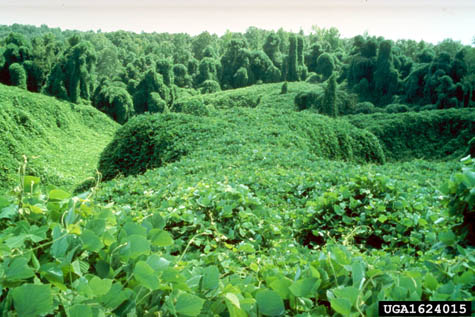 [Image: Kudzu-infested forest; photo courtesy John D. Byrd, Mississippi State University].
[Image: Kudzu-infested forest; photo courtesy John D. Byrd, Mississippi State University].
BLDGBLOG: Do you ever quarantine controlled or banned plants, such as kudzu or marijuana, to prevent them from entering the country?
Redstone: We wouldn’t normally consider that quarantine. It’s more a case of restricting access of non-authorized people to those plants, or restricting the release of non-native species into the environment. When we quarantine plants, it’s not to do with excluding a particular plant type so much as excluding the diseases or pests that those plants might be harboring.
Invasive plants like kudzu (Pueraria montana) aren’t banned, although we have a few species like Japanese Knotweed (Fallopia japonica) and Giant Hogweed (Heracleum mantegazzianum) which are illegal to intentionally allow to spread to natural areas.
I’m not sure whether UK authorities would prevent specific plants being imported. Marijuana (Cannabis sativa), whether in THC-containing forms or hemp, requires a Home Office license to produce and process.
We do also provide a service for UK customs authorities. If they make a CITES (the Convention on International Trade in Endangered Species) seizure, we have a department here that will go out to help identify the plant and tell them whether it’s been wild-collected and if it’s of conservation value.
Edible Geography: Can you give any examples of outbreaks that have happened while you’ve been here?
Redstone: We haven’t had any outbreaks here due to failure of quarantine. The impact of an outbreak on our collection could be very serious, particularly if it involves a known quarantine organism where the only sensible treatment is to destroy the plant material. That could cost tens or even hundreds of thousands of pounds to eradicate. It could also threaten rare species, restrict people’s access to the collections, and prevent us from supplying material for research to our own labs and to other botanic gardens.
We have had a couple of recent pest outbreaks in the UK. I’ve already referred to our ongoing Oak Processionary Moth problem. The interesting thing is that when that outbreak happened, the moth wasn’t even recognized as a quarantine organism and it wasn’t clear which government department was going to manage it.
The problem with all of these things is that it’s so much easier to prevent an outbreak than it is to deal with one that’s already in progress. Unlike in the U.S., where you seem to be more geared up to a rapid response once something has been identified, it takes us a long time in the UK and we need more resources in place to do the monitoring and undertake control.
One issue, for example, is making sure we have the right chemicals in place. It’s not enough to do a risk assessment; we also need a list of specific, recommended control measures. And if the recommendation is, for example, “Use this particular chemical,” then we need to make sure that somebody in the UK is able to supply it.
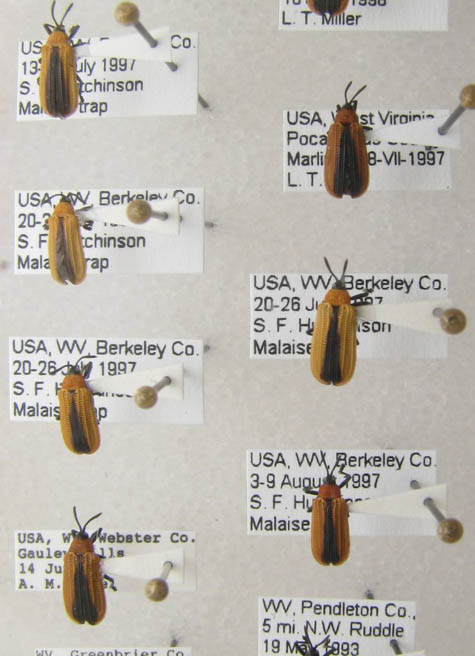 [Image: West Virginia Department of Agriculture’s pest collection, via the Massachusetts Introduced Pests Outreach blog].
[Image: West Virginia Department of Agriculture’s pest collection, via the Massachusetts Introduced Pests Outreach blog].
BLDGBLOG: What’s involved in thinking through the design of a new quarantine facility?
Redstone: One of the design challenges is to make sure that we not only meet current legislation, but that we also anticipate some of the changes that might need to happen. Global trade and climate change are having an impact already.
Even trying to decide the scale of our building is a challenge: we want to build-in flexibility, and we don’t want to hamstring the organization in the future. At the same time, we have to be able to afford to run the facility!
What we know from the experience of others is that there have been lots of examples of institutions where they’ve spent vast sums of money—tens of millions of pounds—on creating fabulous infrastructure, but it has then been so expensive to run that they haven’t been able to operate it. We can’t afford that. That’s not what we’re about at Kew.
On the other hand, to contain pests and diseases, we need to assess the risks associated with every single plant movement. As a result, over the past few years we’ve routinely quarantined material that there’s no legal need to quarantine. However, we’ve felt that there was a practical need and a moral obligation to quarantine seed material that comes from, for example, California, or from other states where we know there’s a really severe problem with Sudden Oak Death. Particularly with the understory material, we’ve germinated it all in quarantine and grown it on so that we can screen it. The last thing we want to do is introduce Sudden Oak Death—particularly the American form, because there’s an American and a European strain, and the concern is that the two will meet and produce a super-strain.
The other factor is the human resource. It’s not enough just to have a building: you need to have people who are trained and who understand how to operate it.
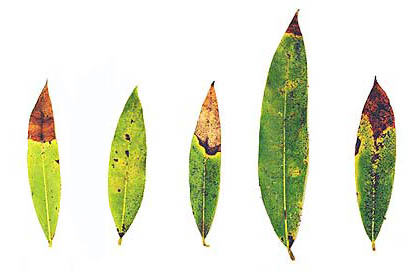 [Image: Bay leaves showing symptoms of infection by Phytophthora ramorum, the “causal agent” of Sudden Oak Death. Photo courtesy D. Schmidt, Garbelotto Forest Pathology Lab, UC Berkeley, via the U.S. Department of Energy’s Joint Genome Institute].
[Image: Bay leaves showing symptoms of infection by Phytophthora ramorum, the “causal agent” of Sudden Oak Death. Photo courtesy D. Schmidt, Garbelotto Forest Pathology Lab, UC Berkeley, via the U.S. Department of Energy’s Joint Genome Institute].
Edible Geography: Quarantine is always a question of time. How do you decide how long to grow these understory plants, for example, before you can determine whether they are healthy or sick?
Redstone: That’s all part of the risk assessment process. I work with our local inspector and an excellent scientific support team at FERA to make those kinds of decisions. For example, the inspector might look at a batch of seedlings and say: “That group hasn’t grown very well—but this group is fine, and they’ve reached three months and we can see that they’re still healthy.” What he might then say is, “The healthy ones can move on”—and he’ll do me a release certificate—“but those other ones ought to stay for a little bit longer.” Or he might say: “I don’t like the look of that first group: destroy them.”
This is always decided on a case-by-case basis—which is very different from genetically-modified organisms, where there are fixed containment levels. What we’ve done with our new building is use the containment levels for GMOs as a guideline when talking to potential suppliers. For example, in terms of treating our water waste, we’re saying to them that we need an equivalent for containment level 3. That means we’re looking at steam-sterilizing all our liquid waste. We’ll take off the solid fraction, and that will be dried and incinerated—or it will be sent through the autoclave—but the liquid will all be steam-sterilized.
The other thing is that all the technology we use needs to be proven and validated. For example, I know of some places where they use an ultraviolet system for treating water, but there are potential problems with that, because if you have high levels of organic matter in the water, things can, in fact, survive. We just can’t take that risk, because it might result in us not getting a license. And if you put an awful lot of effort—and millions of pounds—into doing something, then it would be an awful shame to fail just for the sake of wanting to try something new and cool.
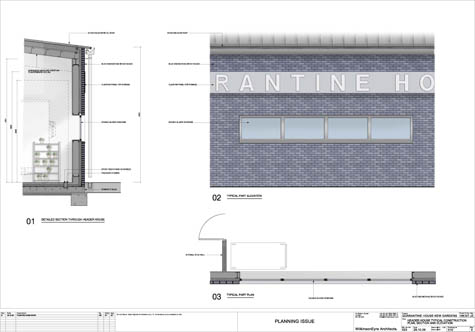 [Image: Proposed façade for the new Quarantine House at Kew, courtesy of Wilkinson Eyre architects].
[Image: Proposed façade for the new Quarantine House at Kew, courtesy of Wilkinson Eyre architects].
Edible Geography: Where does the innovation and experimentation in quarantine design take place, if not in designing a new facility?
Redstone: That’s the problem—it doesn’t. It’s the kind of thing that somebody somewhere should do so that we can test new systems. The trouble is that resources are usually limited in this area and facilities tend to be expensive both to build and operate well. Usually you can’t afford to experiment.
We do test our systems once they’re in place, of course. With the steam-sterilization system that we’re planning to install, we’ll be regularly inoculating it with particular organisms and then testing the processed material to make sure it works. It’s simple, but it’s effective.
I’ll show you the plans as they stand now. [unfolds plans] In the scheme as it stands, we have a reception area which will receive all plant material that comes into Kew: seeds, bulbs, shrubs, trees, everything—whether it’s from the EU or not.

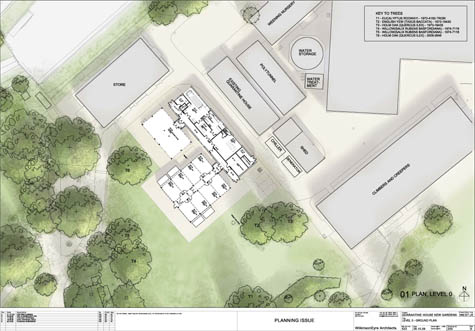 [Images: Site plan for the new Quarantine House at Kew, showing the proposed site (marked with red, top) and the proposed floor plan of the new structure (bottom). Courtesy of Wilkinson Eyre].
[Images: Site plan for the new Quarantine House at Kew, showing the proposed site (marked with red, top) and the proposed floor plan of the new structure (bottom). Courtesy of Wilkinson Eyre].
Edible Geography: What sort of volume is that?
Redstone: Kew receives, on average, between three to five and half thousand accessions a year, and an accession can be quite a large group of plants—it needn’t necessarily be a single plant, if they’re all genetically identical.
The material will then be processed via the inspection area and then either go into the licensed facility (medium and high containment pods) or into the unlicensed large specimen store. The large specimen store’s primary function is to enable us to hold, monitor and, if necessary, treat or destroy trees, shrubs and other plants originating from within the UK and EU.
The large specimen store is basically what we call a high hat. It has a solid roof, which can be shaded, and insect-proof sides. The insect-proofing is aphid proof, so it’s not particularly small—it’s around the 1mm² mark.
Adjoining the store will be the licensed quarantine facility, which will be split in two: high containment and medium containment. Both spaces will be governed by the licence issued by DEFRA. Both units have air cooling—though they each use a different cooling method—and they’re going to be kept at negative air pressure.
We also have to build in systems to allow for a failure in the power supply. As we’re on the edge of a flood risk zone, the building itself will sit on top of a concrete raft and the plants will be on benches. That will give us quite a lot of leeway as far as any risk from flooding goes. As added protection we also intend to have slots at the doorways; we can then put in barriers and reinforce them with sandbags, in the case of a serious flood. I also want to have an operating procedure that says, if we get advanced warning that there’s going to be a really catastrophic flood event, we’ll load everything in the incinerator and destroy it. Frankly, if that happens, most of London is going to be completely stuffed—so there’ll be bigger problems to deal with!
At the entrance to the licenced area, we’re putting in a cold lobby. It will be kept at 0ºC and it will have a freezer for lab coats. People will put on lab coats before they go into the medium and high containment areas and put them back in the freezer when they come out, where the coats will be sterilized. There will also be an air-circulation fan so that, if anything like seeds or pollen has got stuck to people, it will be blown off into the cold.
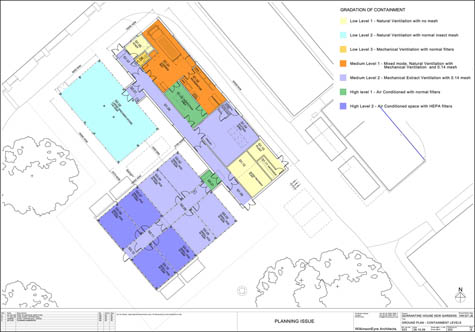 [Image: “Gradations of Containment” in the proposed floor plan for the new Quarantine House at Kew, courtesy of Wilkinson Eyre].
[Image: “Gradations of Containment” in the proposed floor plan for the new Quarantine House at Kew, courtesy of Wilkinson Eyre].
Edible Geography: Will there be chemical showers as well?
Redstone: No, that would be considered excessive, to be honest. It’s all about assessing and managing risk proportionately. We’re not a research facility raising pests or diseases for experimentation, so the risks are somewhat less. We have an emergency shower in case somebody’s been contaminated, during pesticide spraying, for example, but our working procedures and precautions like the cold lobby and freezing of lab coats should provide the appropriate level of bio-security.
At every stage, we’re assessing and trying to minimise risk. If we received particularly precious seeds that I thought might harbour a problem, what I would look to do is send them to the seed bank so that they can X-ray them and we can weed out the bad guys straight away, to be destroyed. We also use external treatments – for example, peroxide or other chemicals. Apart from anything else, peroxide is great because it can help trigger germination and is biodegradable.
With everything, you have to give it a bit of thought first. Which is why we say to staff, for goodness sake, please don’t turn up on the doorstep with plant material. We need advance notice so we can risk assess the material.
Other parts of the facility include the loading bay, where there’ll be some storage, the incinerator area, and the inspection bay.
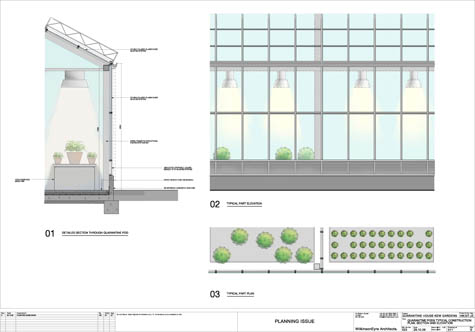 [Image: Wall detail and section of the new Quarantine House at Kew, courtesy of Wilkinson Eyre].
[Image: Wall detail and section of the new Quarantine House at Kew, courtesy of Wilkinson Eyre].
BLDGBLOG: What do you do with the output from the incinerator?
Redstone: The ashes are usually incorporated into the soil heap. It doesn’t go into the compost because it blows around; instead, we usually dig it into the soil piles, so it doesn’t go to waste and it is recycled.
The facility also includes a potting area, which contains a small chemical store and a water-treatment area. And there are going to be insectocutors everywhere!
One important design feature is that the plant room is entirely separate, so that the only way people can enter is through that external door. This means that anyone coming to do maintenance on the electrics or whatever doesn’t have to go through any of the quarantine procedures, because they don’t have access to any other part of the building. It’s human nature to prop open the door if you’re feeling warm—but that sort of thing just can’t be allowed to happen inside the licenced areas.
Edible Geography: How will the temperature-control system work?
Redstone: For the individual zones within the greenhouse, each “pod” will have its own small unit climate control panel on the outside of the house, which will control air circulation, fans, and fogging. We’re going to use fogging not just to control relative humidity, but also, in part, to control temperature gain. It’s quite an effective way of modifying the temperature without huge energy input. And we’re going to use external shading—rollers in tracks—because that’s more efficient than internal shading. Although this is the UK, you may be shocked to hear that heat is the biggest problem we have in maintaining the right kind of environment for our glasshouses.
There’s going to be limited lighting because we’ll be either propagating material or maintaining material—we’re not trying to promote lush growth. There will also be a central computer that controls all the zones, and my intention with the new one is to have direct access from my mobile phone and home computer.
One of the intentions with the new building is to minimize energy costs as much as possible. The building also needs to be capable of being operated by only a few staff—it mustn’t be labor or energy intensive!
For plants that have really critical temperature requirements at the lower end of the spectrum—for example, we had some orchids in from Patagonia—it’s hard to provide those kind of environmental requirements reliably through a glasshouse system. So what we’re going to use is a couple of growth cabinets with lighting, because we feel that’s the most cost-effective solution to that particular headache. We’re also hoping to use rainwater harvesting for part of our irrigation system, and we’re trying to use the most energy-efficient materials.
One of the vendors we’re considering makes quarantine houses using curved polycarbonate sheets. You get a lot of lengthways expansion with polycarbonate sheets, and the curve helps accommodate the expansion and contraction, while maintaining a really good seal. The other thing I like is that we can pump air through a cold water spray and then actually circulate it up and over the curve of the structure, which can give a much more even temperature regime across the bays.
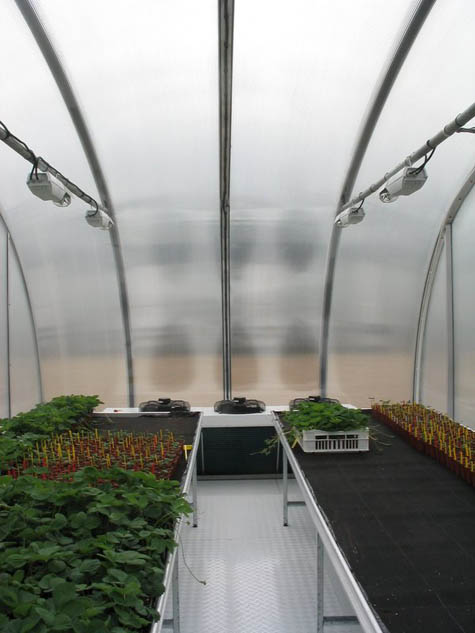 [Image: Curved polycarbonate sheets for glasshouse construction, courtesy Unigro].
[Image: Curved polycarbonate sheets for glasshouse construction, courtesy Unigro].
BLDGBLOG: I see the facility has been designed by Wilkinson Eyre. How is working with them going?
Redstone: Well, the design isn’t finished yet. The final version will be designed and built within the restrictions we’ve incorporated—we are really getting into this now, I think. It’s quite different from anything else they’ve done and the combination of very specific needs, with a lack of specific technical guidelines, makes it a challenging and interesting exercise. We want the building to look attractive, but containment and functionality are its key priorities.
The other interesting design feature is that there’s a five-meter exclusion zone around the building—a completely solid surface with no plant material. We arrived at that measurement through discussion with the Plant Health and Safety Inspectorate, and it’s important to have a clearly marked exclusion zone. Although the old quarantine building began its life being relatively isolated, pressure to use every available square metre of behind-the-scenes space for support activities at Kew means this is no longer the case. We’ve located the new building so we can make use of some of the existing roadway as exclusion. That way we’re not wasting space, and we’re closer to some of the services.
This particular layout also enables us to add on another block, if we need to in the future.
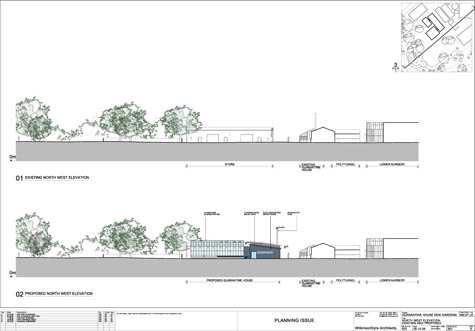
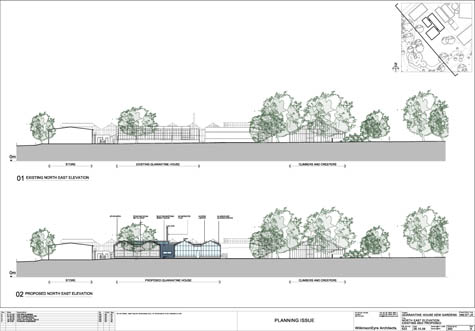
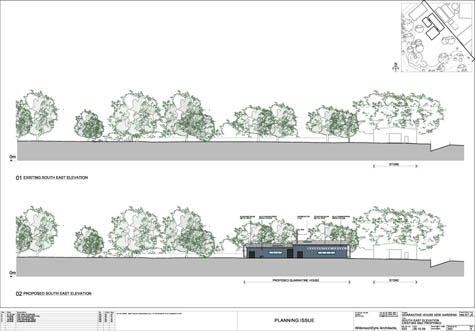
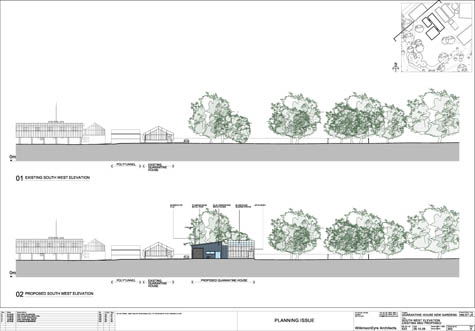 [Images: Proposed elevations—from the NW, NE, SE, and SW—of the new Quarantine House at Kew, courtesy of Wilkinson Eyre].
[Images: Proposed elevations—from the NW, NE, SE, and SW—of the new Quarantine House at Kew, courtesy of Wilkinson Eyre].
Edible Geography: How many plant pest & disease quarantine facilities are there in the UK?
Redstone: A lot of universities have small quarantine facilities, often used for GMO work or raising pests & diseases rather than specifically quarantining plants. Rothamsted have a really excellent facility for experimental work. Central Science Labs at the FERA headquarters in York also have quarantine facilities.
Edible Geography: Does the Royal Horticultural Society have one?
Redstone: No, not that I’m aware of. The National Trust doesn’t have specific quarantine facilities either—although, having said that, they have been working very hard on biosecurity issues, triggered, as they will tell you, by outbreaks of Sudden Oak Death in their collections in the West Country. They have taken stock of the situation and realized that they, like many organizations across the UK, needed to improve current practices. I think it says a lot for the organization that they have been so open and self-critical.
The head of this program for the National Trust is Ian Wright, a head gardener from a Trust property in Cornwall. He realized that through lack of resources, budget challenges, and other difficulties, we’ve moved away from basic good practices: cleaning your materials, cleaning your boots, sterilizing your blades, all those kind of things. For example, if you bring in new plants, you should keep them isolated for a period of time, just to make sure they’re clean—but we seem to have lost a lot of those good habits.
So Ian has worked with David Slawson from FERA to produce a lot of information, as well as posters like this. [unfolds poster] These would go up inside potting sheds, to remind people that quarantine doesn’t have to be fancy. It can be something as simple as a poly-tunnel, or an area behind a shed, where you keep things separate. Containment can be as simple as remembering to wash your boots and wash your hands—basic good hygiene.
In fact, one of the things that we’ve been encouraged to think about by DEFRA is providing a limited commercial service, because there are so few plant quarantine facilities in the UK. This new quarantine facility at RBG Kew will be quite a major one, relative to what’s available in the UK. The thing I’m really excited about is the fact that we’ll have the capacity to control more tightly the stuff that comes in from the European Union and around the UK. That’s increasingly important.
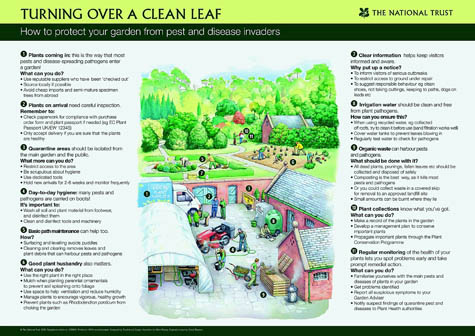 [Image: The National Trust’s “Clean Leaf” plant quarantine poster].
[Image: The National Trust’s “Clean Leaf” plant quarantine poster].
Edible Geography: Did you have any qualms about the decision to locate such a major quarantine facility in the middle of one of the world’s greatest collections of rare and valuable plants?
Redstone: We are in a vulnerable location, in a number of ways. We’ve done a major environmental impact assessment, and even looked at the option of having it off-site, but that in itself created major problems. One of the real issues is that it’s not enough just to have the building; you have to have the human resource.
It also makes sense to have a quarantine facility where the movement occurs. We’re not just accessioning new plant material—we’re also doing quite a bit of repatriation. I think it’s really important that we should be able to return safe material to its country of origin, especially if it’s seriously endangered or on the verge of extinction. We have to be able to hold our hand on our heart and say, “It’s clean, there are no problems, and your only challenge will be making sure it grows and that something doesn’t eat it or squash it.”
It’s not just for stuff coming in—it’s for stuff we’re sending out that quarantine is crucial, too.
BLDGBLOG: How do you interact with the Millennium Seed Bank? Do you quarantine seeds for them?
Redstone: No, they have a quarantine area in their own lab for seed material. However, if they want to grow any controlled or prohibited seeds—for verification by herbarium staff, for example—then that has to be done within our facility. So they can examine seeds, but if they want to germinate them and grow them on, then they have to come here.
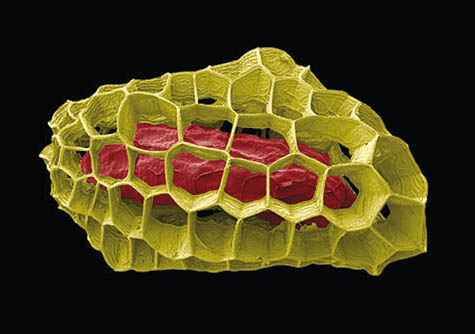
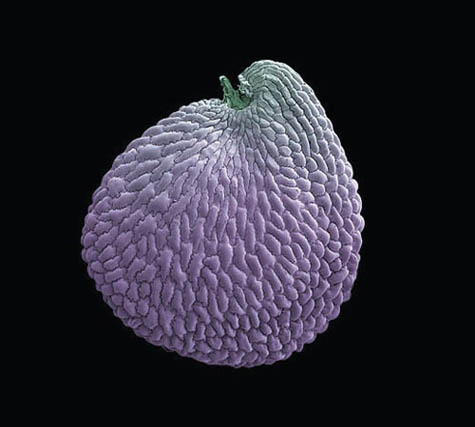 [Image: Electron micrograph images of seeds. (top) Lamourouxia viscosa; (bottom) Franklin’s sandwort, conserved at Kew’s Millennium Seed Bank. Photographs by Rob Kesseler and Madeline Harley, via the The Guardian].
[Image: Electron micrograph images of seeds. (top) Lamourouxia viscosa; (bottom) Franklin’s sandwort, conserved at Kew’s Millennium Seed Bank. Photographs by Rob Kesseler and Madeline Harley, via the The Guardian].
Edible Geography: You mentioned that, in the UK, there isn’t a system where the government gives you the approved quarantine facility plans and you follow them to the letter. How can you be sure your design will qualify for the appropriate license?
Redstone: Well, that’s the case for plant quarantine—the system for GMOs is very different, and I don’t know how animal quarantine operates. In our case, I have constant contact with my colleagues in FERA who will be involved in evaluating the new build plans. If they have an issue with a particular system, they’ll let me know.
For example, I had an inspector on site yesterday who asked, “Have you thought about the door seals? I know that these are really good doors but, to get a good seal, what you want is a little up-stand at the bottom of the door for the seal to butt up against.” It’s all sorts of small details like that.
The difficulty with the project from my point of view has been to make sure it gets enough time and attention now—because I know that if I’m still here when it gets built, my ongoing sanity is going to rely on having made the right choices so that we can physically manage the building. I think that, for projects that are very specialized, like this one, the people who are going to use the buildings often don’t get enough time to actually sit and evaluate what the building needs to do.
Edible Geography: Just writing the brief for it must have been quite a challenge!
Redstone: To say the least. Version 10 got issued about three weeks ago. My biggest worry is that I’ve missed something. There’s just no wriggle room.
Edible Geography: Did you take any of your ideas for your plan from other facilities that you’ve seen?
Redstone Yes. I actually persuaded them to employ a colleague from Rothamsted, Julian Franklin, as a consultant. He is a major quarantine nerd—not only is he really knowledgeable about the plant side of things, but he’s obsessed by technology, so he can tell you that so-and-so needs to be at this many atmospheres, or amps, or whatever. He’s been a real find.
In fact, one of the risks of a project like this is that there are very few experts around—and, especially in the current climate, there are lots of companies who are desperate for work who may claim expertise they don’t really have.
BLDGBLOG: You said you need to avoid innovation at all costs, but is there any aspect of the facility that will be genuinely new or unprecedented?
Redstone:: Nobody’s built a screening house quite like ours, I don’t think, but it’s really just an adaptation of things that we’ve seen done elsewhere. Ultimately, it will all be technology that’s been used elsewhere, but perhaps not in quite the same way. Other facilities have air showers, for example, but most of those haven’t also had a cold lobby. We are combining things—but we’re also trying to play safe.
 [Image: Air Shower diagram, via the U.S. Occupational Health and Safety Administration (OSHA)].
[Image: Air Shower diagram, via the U.S. Occupational Health and Safety Administration (OSHA)].
Edible Geography: What is the old quarantine facility like—and what will happen to it once the new building is completed?
Sara Redstone: It’s a modified commercial glasshouse, about twenty-five years old. It wasn’t specifically designed as a quarantine house: it has no automatic shading, and controlling the internal climates reliably can be a challenge. The water here is very hard, as well, so the building has had a lot of issues with equipment.
The new facility should be operational by late autumn 2010. This time next year, we’ll be thinking about doing the smoke tests and the pressure tests and so on. And once stuff has been screened in the new facility, it will go into the old house and be held there for short periods of time until it goes onward to the display houses.
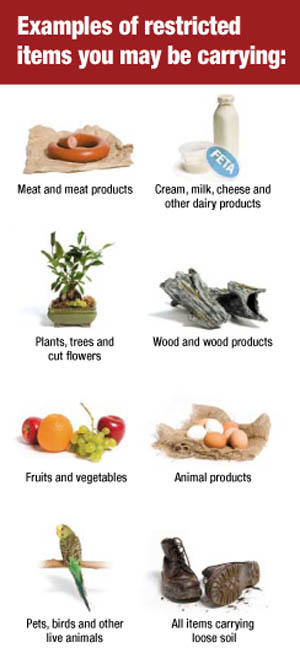 [Image: A fairly standard list of materials that must be declared at the border and potentially quarantined to prevent the import of pests and diseases; this particular brochure is Canadian].
[Image: A fairly standard list of materials that must be declared at the border and potentially quarantined to prevent the import of pests and diseases; this particular brochure is Canadian].
BLDGBLOG: I’m also curious about what happens off-site—for instance, if there is an outbreak somewhere in the Midlands or up in Yorkshire, do you have a field quarantine unit of some sort who can rush out and seal the place off in situ?
Redstone: Not yet, that I know of. You’d need to talk to DEFRA and the Non-Native Species Secretariat who monitor and deal with invasive alien species, or IAS. There is a working group working on developing a protocol for a rapid response against non-native species—NNS—but I’m not sure if they have agreed the way forward.
If the outbreak relates to plants then you’d have to notify—depending on what the host and pest or disease is—either FERA or the Forestry Commission. If the organism isn’t quarantine-listed, then a pest risk analysis (PRA) and other detailed work may be required, and this can take some time to do thoroughly. Depending on where the outbreak is and what it is, there’s then also the need to identify who will attempt to eradicate it and how—and where the resources will come from.
What we really need to do is make everybody aware of the dangers of moving plants. It doesn’t matter if you’re a business or an individual.
I had a person tell me recently that they deliberately altered their suitcase so that they could bring back cuttings from their holidays overseas without being detected. People get very confessional—when they hear what my job is, they have this urge to tell me about all of the plant material they’ve brought through customs without declaring, or all of the farms they visited overseas and didn’t mention on their immigration forms. It’s my worst nightmare.
There have been outbreaks of quite serious pest problems in botanic gardens and plant collections. These have probably, according to the experts at FERA, been the result of things like exotic flower arrangements or of bringing in fruits from around the world to explain to children about plants. Those routes need to be cut off, as well.
Individuals can sometimes be ignorant of the impact they could have by smuggling—in fact, sometimes they don’t even realize that they are smuggling—plant material into and out of the country. We’ve got a bit of money as part of the project to actually do some interpretation on site. I’m hoping that we can do quite a lot to explain to people the risks of moving plant material, and the impact of plant pests and diseases, by having signage in the display houses and in public areas on site.
For example, did you realize that there’s a risk, when you’re moving plants that have soil around the roots, of introducing a pest called the small hive beetle, which can eradicate honeybees? Bees are getting a lot of press at the moment—for very good reason—and so one of the things I’m hoping we can do is use that sort of example to show that the consequences when you smuggle that plant back from your holiday, or when you bring back a jar of local honey, or wax candles, or a wooden sculpture, may be more far reaching than you realize.
If you put things in context, most people are responsible enough not to flout the rules—I hope. We’re all in this together—we all share the same planet.
This autumn in New York City, Edible Geography and BLDGBLOG have teamed up to lead an 8-week design studio focusing on the spatial implications of quarantine; you can read more about it here. For our studio participants, we have been assembling a coursepack full of original content and interviews—but we decided that we should make this material available to everyone so that even those people who are not in New York City, and not enrolled in the quarantine studio, can follow along, offer commentary, and even be inspired to pursue projects of their own.
For other interviews in our quarantine series, check out Until Proven Safe: An Interview with Krista Maglen, One Million Years of Isolation: An interview with Abraham Van Luik, Isolation or Quarantine: An Interview with Dr. Georges Benjamin, Extraordinary Engineering Controls: An Interview with Jonathan Richmond, On the Other Side of Arrival: An Interview with David Barnes, The Last Town on Earth: An Interview with Thomas Mullen, and Biology at the Border: An Interview with Alison Bashford.
More interviews are forthcoming.
Atmospheric Intoxication
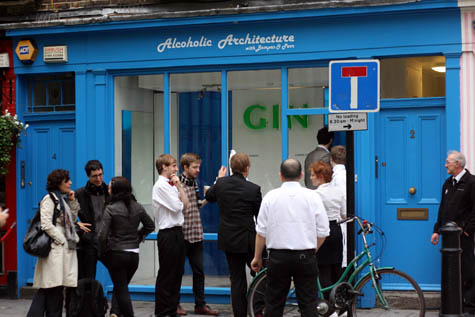 [Image: Photo by Jonathan Brown. Brown reviewed the launch on his blog, Around Britain with a Paunch, writing that he and his friends “mingled in the mist, like shadows on the set of Hamlet”].
[Image: Photo by Jonathan Brown. Brown reviewed the launch on his blog, Around Britain with a Paunch, writing that he and his friends “mingled in the mist, like shadows on the set of Hamlet”].
Note: This is a guest post by Nicola Twilley.
A former boutique storefront in London has become the temporary home for a pop-up bar with a twist: 2 Ganton Street is currently the U.K.’s “first walk in cocktail.” Created by Bompas & Parr (known for their earlier experiments with glow-in-the-dark jello and scratch & sniff cinema), the “Alcoholic Architecture” bar features giant limes, over-sized straws, and most importantly, a gin-and-tonic mist.
Lucky ticket-holders (the event has now sold out) are equipped with plastic jumpsuits and encouraged to “breathe responsibly” before stepping into an alcoholic fog for up to 40 minutes – long enough to inhale “a fairly strong drink,” according to Wired UK.
The Guardian noted that “as far as taste goes, this is the real deal,” with some mouthfuls of air “sweeter with tonic and others nicely gin-heavy.” Sam Bompas explained to Wired that they chose to vaporize gin and tonic (rather than, say, an appletini) because of its “nice smell, botanical flavours and freshness.” St. John Ambulance volunteers are on hand, though the only reported casualties so far seem to have been hairstyles – victims of “gin-frizz”. The Guardian concluded that, “With no sentient ice cubes able to confirm it, one can only assume that this is what the inside of a G and T feels like.”
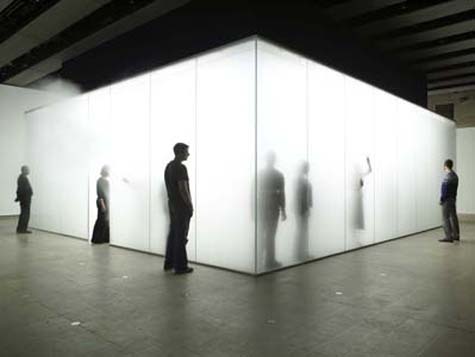 [Image: Antony Gormley’s Blind Light, 2007, courtesy of the artist and Jay Jopling/White Cube, London, ©Stephen White].
[Image: Antony Gormley’s Blind Light, 2007, courtesy of the artist and Jay Jopling/White Cube, London, ©Stephen White].
The project was inspired by Antony Gormley’s Blind Light, a fog box installed at the Hayward Gallery in 2007. Bompas & Parr, who describe their world as operating in “the space between food and architecture,” worked with the same company, JS Humidifiers, to adapt and install the ultrasonic humidifiers that create the thick, gin-based fog.
Though even typing “thick, gin-based fog” makes me feel a bit queasy, the experiment does seem to provide a perfect instantiation of London’s social history, the city’s prevailing damp, and its dense population. If the project is recreated elsewhere, perhaps local conditions will shape the installation: a freezing hail of neat vodka will form a layer of crystals on fur hoods and boots at a cavernous underground bar in Moscow; or a refreshing rum-and-coke mist will cool sunburned spring-breakers in the overcrowded hotel rooms of Daytona Beach.
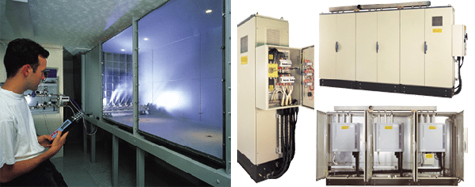 [Image: JS Humidifiers].
[Image: JS Humidifiers].
Of course, the architectural manipulation of humidity is not limited to alcohol. As JS’s website boasts: “For precise control of humidity and temperature, extreme outputs, specialist construction for controlled environments or unusual control, whatever the requirement JS will design and manufacture a solution.” Existing clients for these bespoke humidification systems apparently include medical device manufacturing, offshore oil exploration, firearms production, specialist printing, pharmaceutical production and automotive manufacturing. It seems clear that custom atmosphere solutions are a product with endless applications: migrating from industry to art to retail, with the next step being high-end custom interior design for the very rich.
It can only be a matter of time before wealthy individuals are able to wake up to vaporized coffee, maintaining their multi-tasking edge by inhaling caffeine for that last half-hour of sleep, while the riders of Hollywood stars will routinely specify custom dressing rooms bathed in a fine mist of light-diffusing, age-defying elixirs.
[Other guest posts by Nicola Twilley include The Water Menu, Dark Sky Park, Park Stories, and Zones of Exclusion].



